
You either disagree with DARWINStheory of "EVOLUTIONof the SPECIES" or not. you will not deny though that a Group visit to the home of the great man is very welcome
rt J ..... (/) rt ::,(I) .... ., (/) rt ..., (I) 8 ..., a. 0 .... )> ..., 3 g ..., rt ..., WINTER85-86 issue .EDITED hy:Victor.J.Heppelthwaite ARPS. tr f'!lo)ls HH•Ht 1 frat• tr•Ytn.,.,. u lr•h1'.MUl,U... a..l•fl'MltJMrtkt M•, l!tl.teO-Ylllac-, 11-. JI- h • MU &tit 1~ O. s.&~,li RCF:fo'Mourc T.Q. t;-3:J~/2 see page 39
ARCHAEOLOGY & HERITAGE GROUP of the ROYAL PHOTOGRAPHIC SOCIETY
2/ 3/4 5/6 7/8 9/ 10/15 16/19 20/21 22/23 24/ 25/ 26/27 28/29 30/ 31/32 33/ 34/35 36/7 38/ 39/ 40/ ' I , ~~:__"-. • ti_tJ~f ·~.ftl"a_..:·.., :....,,.;,/;~,.1_..,...,~.::•~~;.. :~·,
(X)NTENTS. / ONTO A "WINNER ?"
VIEWPOINT.ByERIC HOULDER. REVIEWS
'85' Conference NEWS.J.W. PROGRAMME1986-7 Conference REPORT85.J.W. A 'HOLOGRAM'camera.T.Dawson. Building your 'Haselhof' VICTOR "SUNDOWNER"By J. W'.' A DESERVING CASE READERSLETTERS
"HERITAGE in the MAKING"B. T. A A&H Group visit.
The "SHOT TOWER" by A.BEALE. "A PRIVIAL PERSUIT" 1986/7 programme cont: "TORALBA" by ••.•• ?
"Our visit to "STOKE D'abernon~ now for "Sl.J.1THIN DIFF' RNT" "DOWNEHOUSE" a visit is arranged "TAILPIECE" by the Editor.
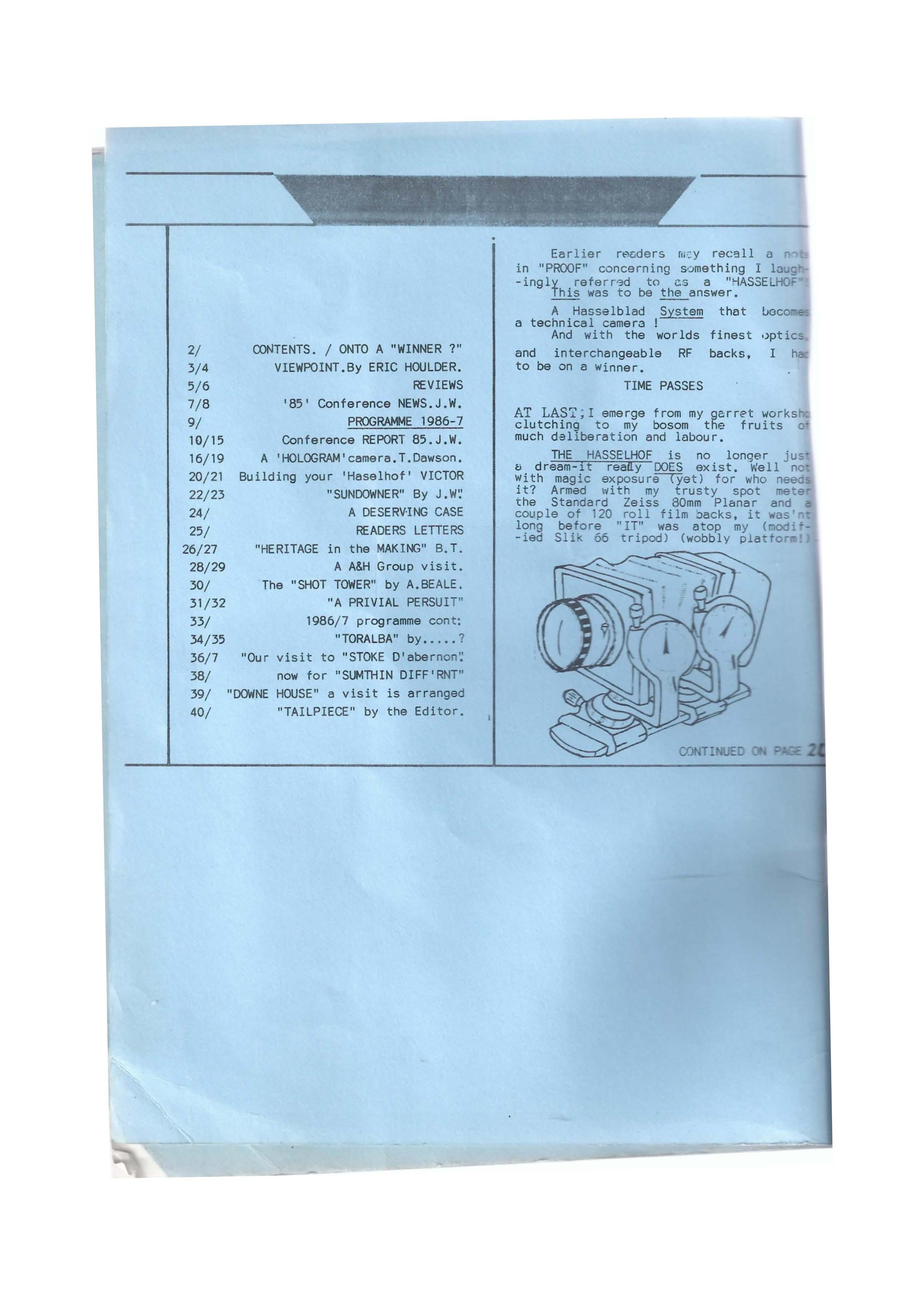
Earlier r~~c:;ders r,,~y rec':lll a "" in "PROOF" concerning something I l.::iug -ingly referr-;id to cs a "'-iASSELHOF This was to be the answer.
A Hasselblad _§y_stem that a technical camera I
And with the worlds finest and interchangeable RF backs, I to be on a winner.
TIME PASSES
AT LAS?; I emerge from my gcrret worksr clutching to my bosom the fruits o· much daliberation and labour.
THE HASSE-LHOF is no longer jus a d ream-1 t ready DOES exist. Wel 1 no· With magic exposureTyet) for who need it? Armed 1~ith my trusty spot mete the Standard Zeiss 80mm Planar and couple of 120 roll film .:>acks, it was' • long before "IT" was atop my (modi•-ied Slik 66 tripod) (wobbly platter •
By Eric HoulderL RPS

val1 enm
Oa tile tin'I ot Jae I le4 a NUil part7 fNa ne leeal U'dMelecloal aooiri)' h Bailriaa'• •.u. •on ot tile ,-ri7 lul4 ne Mia aUe• a Pl'ffi eoou1 , HU wu a t'ler et -. be tile •j la• i.J1 the •arie:ra halt et u .• lfall llldoll are alH MONai'bl• 'lo • ·-· oeapNm.H wu, et onno, a NIJU7, 'Inn ill th• u4 n cleoid.o4 1io toll• tile M318 fNa Bo44oa rlftiq Vall,.ti'loll aal Yall!u fNa no ooaoh. Lua WU ta at the IIU:lt.rana a.tie whioll n parke4 no fllliolo at Stool li,c. fllo tiUu ._'bon na walb4 11P ViUlliolu enc llldlat t:11.o i. •• tu lla4 • loolc at the iapNHiTO HOUoa 'bel'ow Cat Hain ••• tlla drffo 4na to Y1111lolu4a aa4 fr. nee to tho an llaaaa u,q Jtu._ at C&l'"f'oru. fll• an OU' pan:Ji.ere IUllco• Valll:lown Oraca aooHaiblo to a ooaoh p&ri7 tor the tint u .. , &114IIU1' ot th• grou.p u.nacocl h both oraca a:a4
lJl apito ot rq pNriou fairl.7 ooapNhou1n eoTor ia 'bot:11.'!/v aal oolov, I llanapd. h nearl7 a hlll. tila ot oaola, ju'I ,apclaUag on plao•• lilco Yillllol&llda, u4 talcinc ad.TUt-«9 ot tile npu'b natll•r h pi beUor piohrH ot other plaoH. I uocl. :,p4 wUll (olliotl.7) a Caleb 7011ft and l"a.jiolaroao D 100 with a polar1aor.
Oil• 'boJlllll wu 1;o HO the 'brolca-ott Stuopb ailHha• an ~IT Z'ffoalo4 alonpiclo tb,o Njunn,.tocl. Stuepto jut nn ot Cll.onorkolao. I onl.u•t tiJld. thi• the lut·uao I walb4 alone heNI J. oll.alloo wu alao 'i h pro4uo an aopUn• of the faana ailenn.o ia the h•ll• oppHi h Ohenel"holae. I 'UN a P'••·f1l hr h lisllhll u .• 7oug •pring toliac- whioh otllU'WiH 1io onr power U. Sl:perieaoo hu ahowa tha, the aep ot •uh pop111.ar 1111.bjeo,• that cme hu, the lilcol7 "h•7 are h 'bo uocl..
'lib llotona;r uhork a:a4 'lh• uw 411&1OU"riac-wa;r nt ot •nouU• IUllco a big clittoNaOe 'lo jnraq fr• ,ho lf1' tirn ooaoh P-"7 to "h• Vall wu 1a 19'5. Ve lof'I; POJltot~ at 6-30 aa and arri"4 llaok •"· 11-00 JIil•, ffft ao, n n.17 had tov hnn ao'l11&ll.7 a the Vall. lftl'Dq are an l•H thaa halt what thq were. If ur, ot nr an'ben b. the d.eop •mh f&IIOJ' a 4a;r oa tll.o Vall I wo111.clwilliagl.7 pid.o a ooaoh ~. 'lhialc a'bo'llt U I
3 t!DINIH
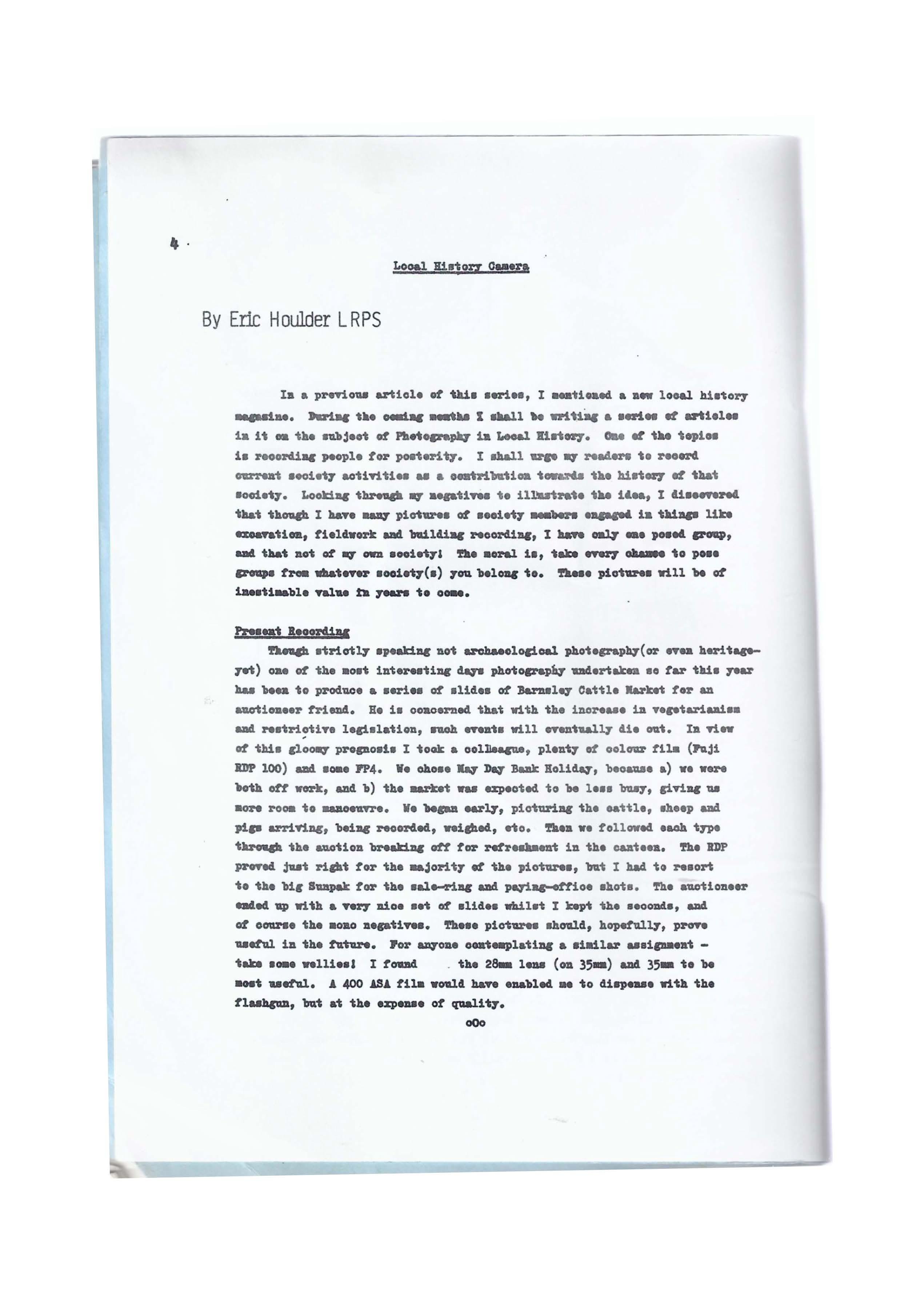
Looal lli1to17 Ouera
By Eric HoulderL RPS
Ia a prni.ou ariiole of '\hi.a I auUoaecl a loo&l hi1'to17 -cut••· hrlJlc tile O..S.ac...tu I u&ll lle 111'H1iic a Hri ot uU•l•• ia H 11111the 111.bjeri of Phe'liopaPQ 1a Loo&l Jlinor.,. Ou ot tu hplH ii reool'lliac people tor ponerU7. I vp-, rea4en t• reoord. OVNa1i 1eoie1i7 aoU'riUH u a o..tri'baUoa tonzou the hiriOl'7 of 1iha1i LooJcbg 1ihreqlt.-, aep.UTU 1io ill'llril"&te tu H.ea, I tha'li 1ihoap I han au:, piriUl'H of Holri7 --Mn la 1;]11Dp lib UO&T&Uoa, fielclworJc aa4 'ballcliq reool'lliq, I haft oal7 •• po1e4 P'OIII>, &114tha1; llot of WIT owa !lie 11, tab ffV7 ollaaN to PH• pnpe fNa a&hTff 1ooln7(1) 7011 belong to. !Jiu• piohNI will be of T&111e tJa 7M:N 'lo ooae.
lleoo,,Uy
!'&np nrinl;r 1peald.ag llO'li U'Ohaeolocto&l phohgraph;r(or n herit-,... ;rri) oae of the ao11i ill1iore1Uag clq1I phnoeraPhT u4er1ialca tar tlli• year be 1io procluce a of of Baruley Cattle JIU'Jce1i tor aa &11riiolleer triead.. lie i• ooaoel"lled. that with the iaoN&H la ••ptariui•• &114
111.0h will n-hall;r 41• out. Ia 'Yin of thla gloOlliT I hcalc a oolllN,pe, pleat7 of oolcnar tlla (Plljl llDP 100} an4 l'P4. •• ohoH Jlq Da;r Baalc Jlolid.a;r, beoau• a} •• WON llo1ih oft work, aad. b} 1ih• aarket wu upeotecl 1:o be loH bu7, gi'riag u rooa to •• bepa HZ"l;r, pio'liunag the oattle, lhHp aa4 pip arri'ring, being reoord.K, -i&hed., no. !lloa •• followed oaoh type 1illroqla 1iho auoUoll bN&ld.ag oft tor Nfi-ouaeat ill the oaatHa. !lie UP prned. jut right tor th• -jorit7 ot the pionrea, 'bat I ha4 1io 1io the big a-pale tor the a&le-riag and pa;riag--otfioe all.o1i1. 'l'h• aucUoaoer OJl4ecl ,ap w111ha T01"7 Dio• H1i of aliclH whilst I Jcep'li 1ih• Hoonda, and of oom-ae the nop.Una. 'l'heH piotvea aholll.cl, hopotul.l;r, proTe uotul ill the future. J'or &111'0lleooatoaplaUag a uaipaeat'lab IOIIO -111 , I fou4 the 28- lou (Oll 35-) aacl 35• 1io be uotul. .l 400 JS.l tila wolll.cl han •-bled. ao to cliapo11ao with the tluhpn, 'bat at the expeuo of qual.11;7. oOo
Grads are on course
THE Royai College cf Art in London is to offer Britain's fi:st post-gradua~e MA course in crea !.ive photogi·a~'
.: rill '.:dve artists and designe!'t. the chance to use hol0gi phic equipment in prep.ration for the expected de;::uandin the use of this new three-dimensional form of communication.
Six full time students have already been accepted for the first intake in October.
As well as the two year MA
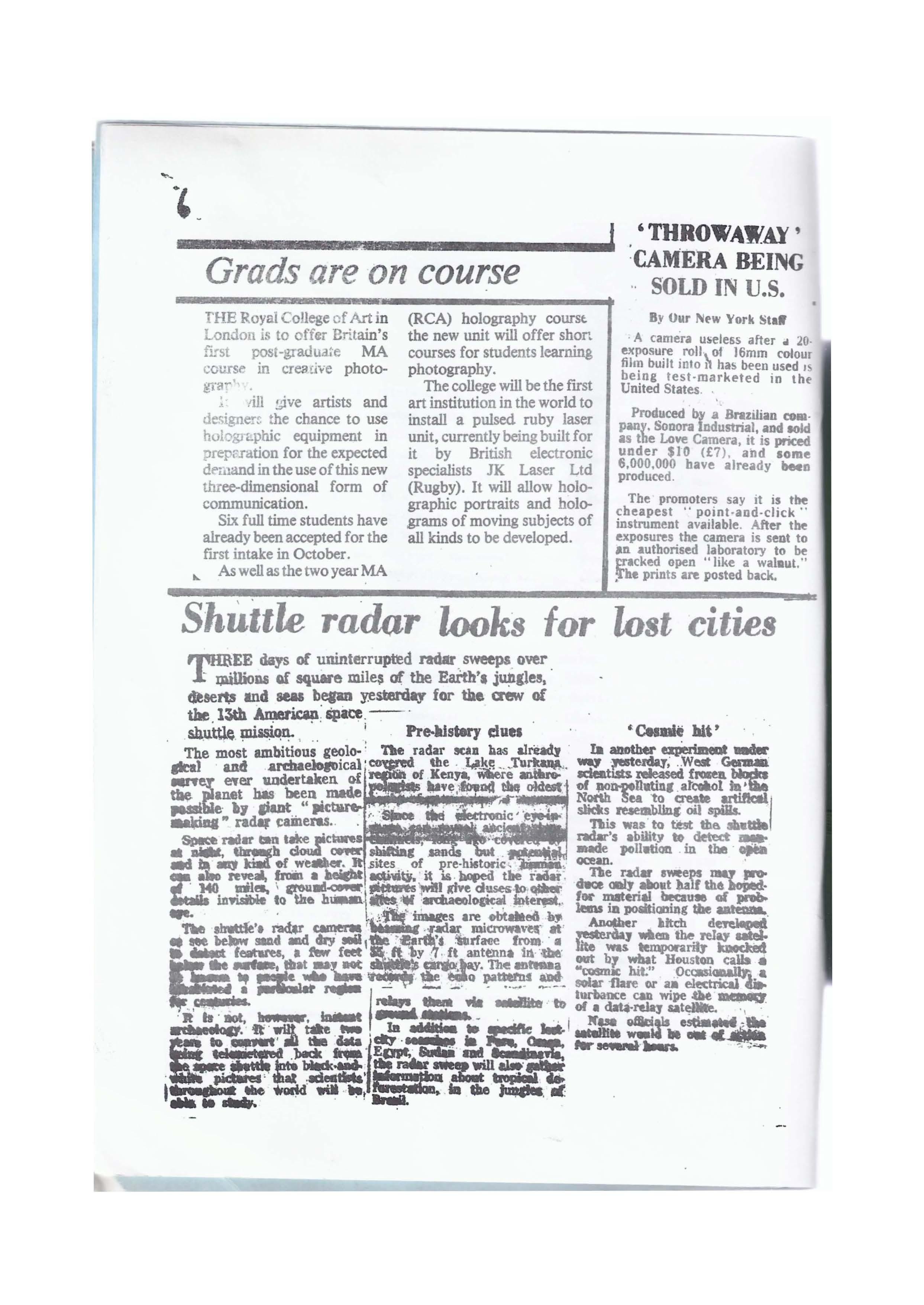
(RCA) holography courst. the new unit will offer shor. courses for students learnin& photography.
The college will be the first art institution in the world to install a pulsed ruby laser unit, currently being built for it by British electronic specialists JK Laser Ltd (Rugby). It will allow holographic portraits and holograms of moving subjects of all kinds to be developed.
. 'THROWAWAY' ·CAMERABEING
.. SOLDIN U.S.
By Our New York Sta•
· A camera useless after ,. 20exposure roll of 16mm colour fil~ built into h has been used , being test-marketed in the United States.
Produced by a BraziliancomPilllY,Sonora Industrial, and IOld as the Love Camera, it is priced under $10 (£7). and some 6,000,000 have already been produced.
The promoters say it is the cheapest " point-and-click instrument available. After the exposures the camera is scot to Jn authorised laboratory to be p-acked open " like a walaut." !fhe prints are posted back,
Shuit"leradar "looks for Inst cities
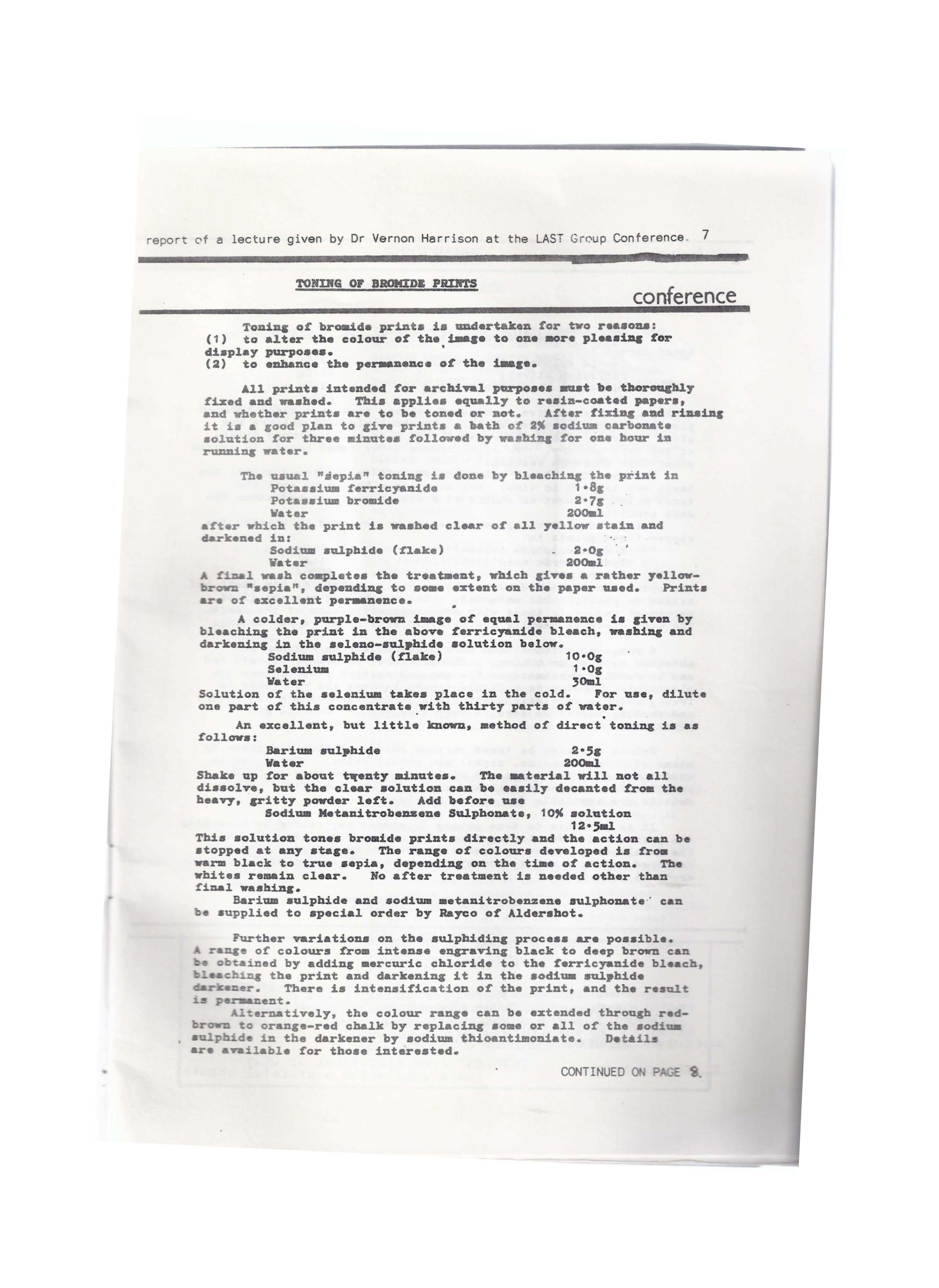
report 0f a lecture given by Dr Vernon Harrison at the LASTGr0up Conference. 7
TONil'fG OF BBOMl'.D&PRDITS conference
Toniq of broaid• print• i• mulertaken for two reaaona:
(1) to alter the colour of the iaa1• to on• aore pl•••ins for diaplay purpo•••• •
(2) to enhance the peraan-c• of the iaa1••
All print• intended for archi,,.l parpoa•• _.t b• thoroacllly fi:Jced and -•h•d• Thi• appli•• •q-lly to reain-coated and whether print• are to ba toned or not. After fiziq and rinaiq it ia a 100d plan to 11•• print• a laath of 2• carbo-t• aolution for three followed by -•bins tor one hour in runniq -t•r•
Th• uaual "••pia" toniq dona ferricyanid•
Potaaaium bromide
Water by bleachiq the 1•81 2•71 200al print in after which the print ia -•h•d cl-r of all yellow atain -d darkened in:
aalphide (flake)
Vater
A final -•h co.plate• the traataant, which 11••• a rather yellowbrown "••Pi•"• dependiq to aztent on the paper Print• are of excellent peraanance.
A colder, purple-brOW'll iaage of •q-1 permanence i• 1i•en by bleachiq the print in the above ferric::,anide bleach, -•bins and darkening in the aeleno-•al•hide aolution below.
Sodium aulphida (£lake) 10•0g
Selenium 1•0g
Water ,0.1
Solution of the aelenium place in the cold. for use, dilute one part of this concentrate_with thirty part• of
An excellent, but little knowu, of direct toning is a• followa:
Barium aulphide 2•51
Water
Shake up tor about t,renty
The -terial rill not all diaaolve, but the clear aolution can be easily dec-ted the hea.y, 1ritty powder left. Add before
Sodium Metanitroben.zene Sulpho-te, 10~ aolution 12•.5a].
Thi• aolution directly and the action can be •topped at any •tas•• The raqe of colour• deTeloped i• -rm black to true aepia, dapendiq on the time of action. The whites re-in clear. No after treatment is needed other than final washiq. aulpbide and sodium aulpho-te·· can be aupplied to apecial order by Rayco of Aldershot.
Further on the sulpbiding proc••• are poasible. A raqe of colours from intenae engraving black to deep brown can e obtained by adding mercuric cbloride to the ferricyanide bleach, leaciu.n. the print and darkeniq it in the aalphide darkener. There i• intenaification of the print, and the result is peraanent.
Alternatively, the colour range can ba eztended through redbrown to orange-red chalk by replacins or all of the aodiua •ulpbide in the darkener by sodium tbioantimoniate. Dat•ils are aY&ilable for those interested.
CONTINUED ON P _ i

8 "TONING" continued 2
An old method ot toning i• with copper. The print i• toned direct in:
Cupric •ul.phate (cry•tal•) 2•5g
Potaa•ium citrate 22•0g
Pota••i- terricyanide 2•0g
Yater 200ml.
Toninc i• rapid to sive a rana• ot colour• black through plum brown to purple-red chalk. The moat plea•ias colour• are SiTen by brief toning and the gold toned albumen print• ot the laat century. No atter treatment ot toned print• ia needed other than thoroqh -•hiq.
Bacauae ot •ilvar aal.t• latt in the toned print, the iaage _,. tarRi•h in U.meJ but esperience baa •hown that the toned print ia about a• atabla aa a ailver print •tored under the e condition•• Print• ot archival permanence can be obtained by pl.aciq the copper-toned print• in:
Sodi- -·phide (t'l.ake) 1•0g
Hydrochloric acid (1:2) 6.i.
Water 200al. The operation i• ba•t dona in the open air becau•• ot the •••11and action on photographic -terial. Tbe aul.phidiq proc••• siv•• red-•apia tone• with intenaitication ot the iaas•• Th• pleaaiq r••ult• are obtained with briet copper toning.
A ranee ot col.ours trom black to red can be obtained by uranium toning. Th• •al.t aaed i• uranyl. nitrate and can be readily purcha•ed as the non-radioactive iaotopea are now plentif'ul.. Toniq a little tricky becaaae the red image i• freely aol.uble in alkaline •ol.ution, including ordinary tap -ter, and bas to be done in very weak acid. Details are avail.able.
Prints can al.so be toned varioua •hades ot blue and green by meana of iron, vanadium, nic~el and cobalt salts. These can be uaeful. tor some landscape and winter •cenaa, but they are not auitabl.a for arcbaeoloaical and architectural aubjects. Again, detail• are a'Yailabla for anyone intereatad.
It i• po•sibl.e to tone prints to almo•t any colour by bleachiq the print• and radevelopiq ·them with a colour coupler added to the developer. However, dyeatuff's are tar more fllaitive than coloured -lt•, and dye toning ia not r•c-•nded tor archival work.
Vernon Harrison
T. Herhert Jones fRPS
It is with pleasure that we record that T. Herbert Jones has been elected a Fellow of the Polish Photographic Society of Great Britain ( FPPS) not only in recognition of the artistic merits of his own work but also for his contribution to the Polish Society.
"STOLEN" from HISTORICAL Gp Qtly with appologies & grateful thanks
PROGRAMME 9
PROORAMMB OF EVENTSFOR 1::186
Sun~y 16th March 1986

Weekend 11th to 13th April
April 1986
SatW'd.ily 19th April 1986
Visit to "The Dovne House", Downe Village, near Orpington, lent. This vas once the home oi' Charles Darvin, & members should meet at "The Dovne HoU$e11 at 10am. Phone Alex Simmons Farnborough Ient (ti6) 58945 to coni'irm it you wiah to attend,
Archaeology & Heritage Group Spring Coni'erenc:e, To be held at the Cryatu Palace Sports & Cont~ ence Certre, London. A lull & varied progruae is planned. Details from Victor Hepplethwaite A,i,P,S. Telephone Orpington (66) 23325
Archaeology & Heritage Group A.G.M. Date & venue to be aranged.
Group visit to Hu.,~ ;. ColU't Palace & gardens. The daffodils should be in blooia providing a superbly photographable display. Please telephone Dr Mike Apted to contil'II, telephone 0372 65901 We will meet at Hampton ColU't StatiOA at 10,30u on the day.
Weekend 16th to 18th K~
Archaeology & Heritage Group visit to Bristol, to visit the docks area. This should be a worthwhile u the historic harbolU' area is being ..S.pted tor leislU'e activities. There are a wealth ot 111\We\aS galleries & exhibition halls to visit u well u Brunell'• s.s. "Great Britain". Detaia i'roa John Walden 01-856 1026 or Charles Browne Ieynahu(02756) 3116.
S&turd&y 21at Jw:ie 1986
Consecutive weekends 2nd/3rd & 9th/10th August 1986
For two weeks i'll'OIII 6tb to 20th September 1986
Group visit to aee & photograph Walthu Abbey, in the c0111panyof Kr R.H,Kason, F,B.I.P,P., Hon. F,R,P.S, We will meet at the Abbey ctt 10.30am on the daiY• Pleue phone John Walden, 01-856 1026 if you will be colllllling along.
Archaeology & Heritage Group SU11111erBxhibition. This will take place at the "Old Barn", which is ' situated in the gardens adjoining the MU$eWll 1 100, London Road, Forest Hill, London, s.g.23. I£ you wish to enter yolU' work, or it you would like to help to steward the exhibition, pleue contact the Hon. Exhibition Secretary, John Spence L,R,P,S. telephone 01-467 5325,
Archaeology & Heritage Group UPe di tion to llorthel'll Spain, Acco11111odAtionwill be in appartments, & there are niaey historic Churches & sites ot interest to photograph in the area. Aproxi-te coat will be £200 & details will be available from John Adau, 0372 373430,
CONTINUEDON PAGE.JJ,
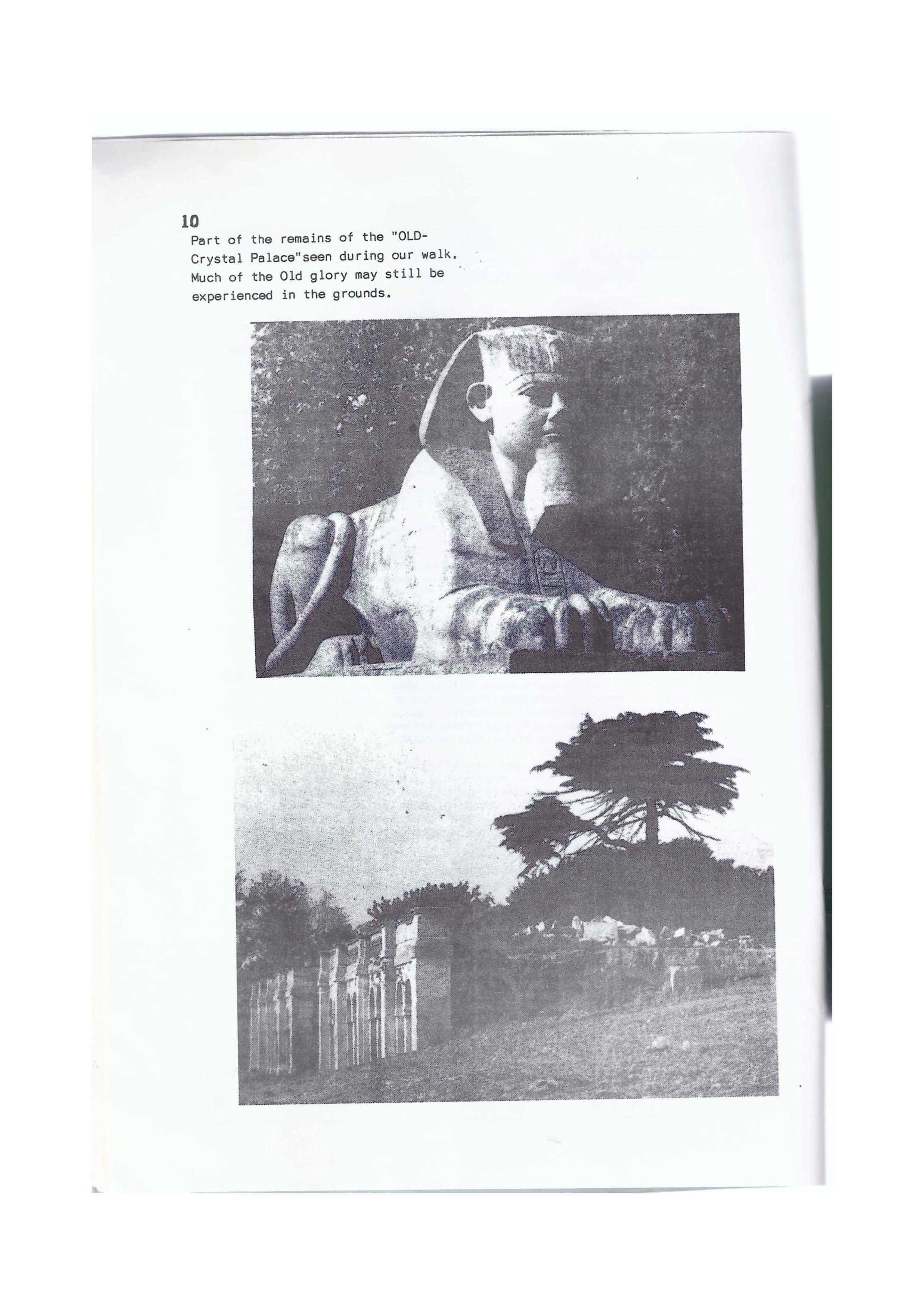
Part of the remains of the "OLDCrystal Palace"seen during our walk, Much of the Old glory may still be experienced in the grounds.
10
Royal Paotographic Society
Archaeology & Heritage Group
1985 Coa.ference Report.
By Jomi 'w'alden.

The Conference began on a beautiful sunny Friday evening at Crystal P.lace svorts & Conference Centre. After sherry & a substantial dinner, a pleasant hal£-lllour was spent outside in the swishine. The conference proper got under vay-with a talk by Dr Vernon Harrison, Hon. F.R.P.S., F.R.S.A., about tintin!at & toning methods.
There are many "recipies" £or the preparation of the various chemicals by which prints may be treated & Dr Harrison brou3ht along several examples £or us to look at. In tlle last issue of "The Proof", Jim Brown wrote aJl article explaining something of the basics about monochrome priat toning, & it was very interesting to view some of Dr Harrisan•s vork illustrating the effect of various methods upon the actu.l photographic ima.ge.
It m.y be said that in ~ecent years sepia toning has not beea very fashionable, however this is surely di.le to change & toning will have something of a revival particularly .mong member• of this Group a.fter reading Jim Brown's article & listening tu Dr Vernon Harrison•s most interesting talk on t.be subject. It seems that there are very real a(lvantages in print toning in terms of tae archival permanence 0£ photographs, It can be disappointing to iook back on photogr.phs taken only ten or so years ago & to find that they have lost some of their original "sparl..le". By toning tlae pri.Jlt it is usualy possible to achieve a finished photograph Yhich will retua its iiuge almost indefinitely.
Following this talk, Mary Mitchell explaiDed to us something of the york of Oxf;un; in particular about the problems of coping Yith the m.nagement of hygiene & seyage in refugee camps. After disasters, caused by war, earthquakes, hurricanes, cyclones or drought; there often arises the prublem of a very large number 0£ refugees who arive together & who have to be looked after. It is not jw;t & question of providiag food & shelter, but also the problem of the ma.Dagement 0£ large amounts 0£ sewage. Tlais is a topic which rarely gets discussed perh.ps owing to some embarrassment, but it is of vital importance. Unless proper provision is llwlde the sprea4 Qf dise.se, such as cholora & dysentery becomes absolutely rampant.
Ho1i1ever, Oxfillll does have an answer Yith a British iavention called the "Oxfam Sanitation ;Jut". This has been developed to provide & completely self-contained silnit.tion & sewaye treatment system. It is a latrine Yhich can easjly cope Yith the needs of 1000 people a day, & which costs comparatively little- some £5000 at the present time- is easy to assemble & readily tran.iportable Yeiyhing about 775kg in total.
It is a sai £act that ·t~ organisatiollS such as Oxfam have Mver been so necessary, & our thanks ml.lst go to Mary Mitcbell £or bringing to owattention just one way in which Oxfam is helpin!) people· in our troubled \iorld. After coffee, it was film time. Some ot our number weat out to try the delights ot the local aostelry, Yhile the rest w.tched two films. The first about• C.nadian inventor, & the second .bout Exeter Catheual. These were brought to us courtesy 0£ the Nati~ Film Board 0£ C~da.
11
12
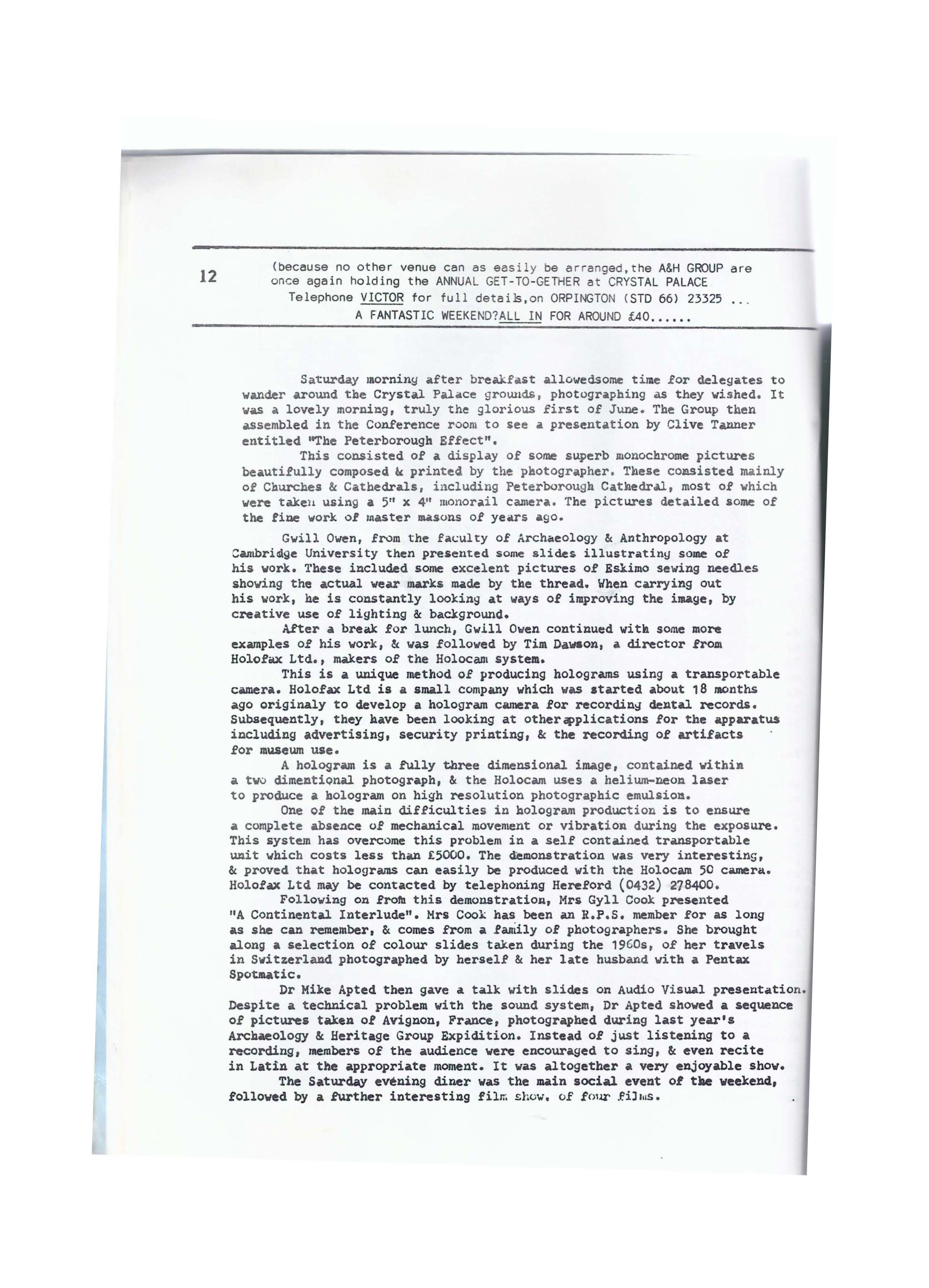
(because no other venue can as easily be arranged,the A&HGROUPare once again holding the ANNUALGET-TO-GETHER at CRYSTALPALACE
Telephone VICTORtor full detais,on ORPINGTON(STD 66) 23325
A FANTASTICWEEKEND?ALL IN FORAROUNDi.40 ••••••
Saturday morning after breakfast allowedsome time £or delegates to wander around the Crystal Palace grow1ds, photographing as they wished. It was a lovely morning, truly the glorious first of June. The Group then .ssembled in the Conference room to see a presentation by Clive T.umer entitled ''The Peterborough Effect".
This consisted of a display of some superb monochrome pictures 'beautifully composed~ printed by the photographer. These consisted mainly of Churches & Cathedrals, including Peterborough Catnedr.ll, most of which were take11 using a 5" x 4'' monorail camera. The pictures detailed .1,omeof the tine work of master m.sons of years ago.
Gwill Owen, from the fa~ulty of Archaeology & Anthropology at CambriGlge University then presented some slide5 illustratin!J some of his work. These included some excelent pictures of Eskimo sewing needles showing the actual wear muks m.i.de by the thread. When carrying out his work, he is const..ntly looking at ways of improving the iiuge, by creative use 0£ lighting & background.
A£ter a break for lunch, Gwill Owen continued witn some more examples of his work, & was followed by Tim Dawson, a director from Holofax Ltd., makers 0£ the Holocam system.
l'his is a unique method 0£ producing holograms using a transportable camera. Holof.x Ltd is a small comp&ny which was started about 18 110nths ago originaly to develop a hologram camera £or record.in~ dental records. Subsequently, they have been looking at otherc1>plications £or the apparatu.s including advertising, security printing, & the recording 0£ arti£acts £or 111useumuse.
A hologram is a fully three dimensional image, contained within a two dimentional photograph, & the Holocillll uses a heliwn-neon laser to produce a hologram on high resolution photographic emulsion.
One 0£ the in.in difficulties in hologram production is to ensure a complete abse11ce 0£ mechanical movement or vibration during the exposw-e. This system has overcome this problem in a self contained transportable wiit which costs less than £5000. The demonstration was very interesting, & proved that holograms can easily be produced with the Holocaru 50 camera. Holo£.x Ltd may be contacted by telephoning Hereford {0432) 278400. Following on £rofn this demonstratioR, Mrs Gyll Coo.k presented "A Continental Interlude". Mrs Cool: has 'been an R.P.S. member £or as long .s she can remember, & comes from a family of photographers. She brought along a selection of colour slides taken during the 1960s, of her travels in Switzerland photographed by herself & her late husband with a Pentax SpotNtic.
Dr Mike Apted then gave a talk with slides on Audio Visual preseRtation. Despite a technical problem with the sound system, Dr Apted showed a sequence 0£ pictures taken 0£ Avignon, France, photographed during last year's Arch~ology & Heritage Group Expidition. Iruitead 0£ just listening to a recording, members of the audience were encouraged to sing, & even recite in Latin at the appropriate moment. It was altogether a very enjoyable show.
The Satur~ evening diner vas the main social event ot tllle weekend, followed by a £urther interesting filrr, £ho...,. of frna- .P.iJ111s.
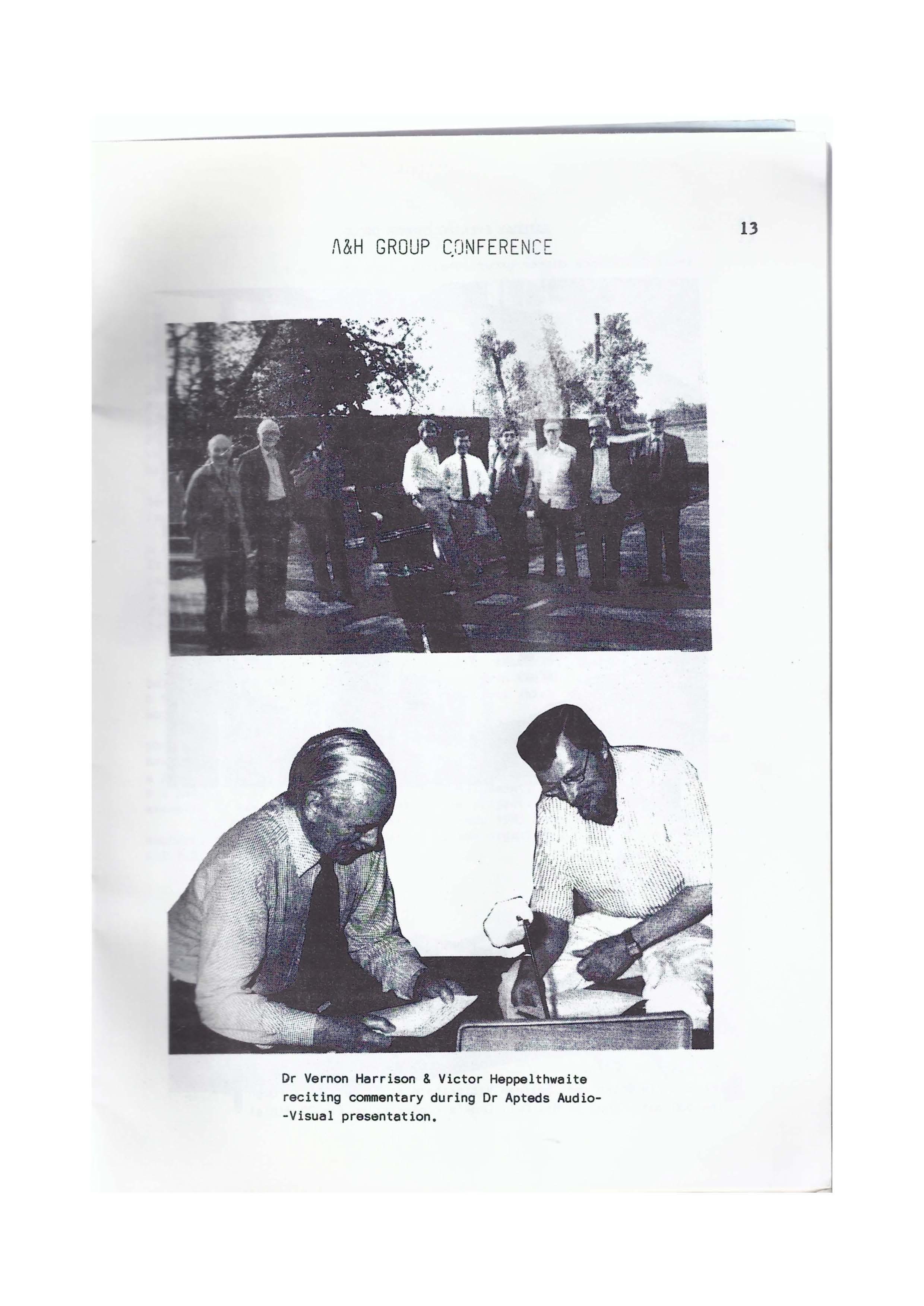
A&HGROUPCONFERENCE
13
Dr Vernon Harrison & Victor Heppelthwaite reciting commentary during Dr Apteds Audio-Visual presentation,
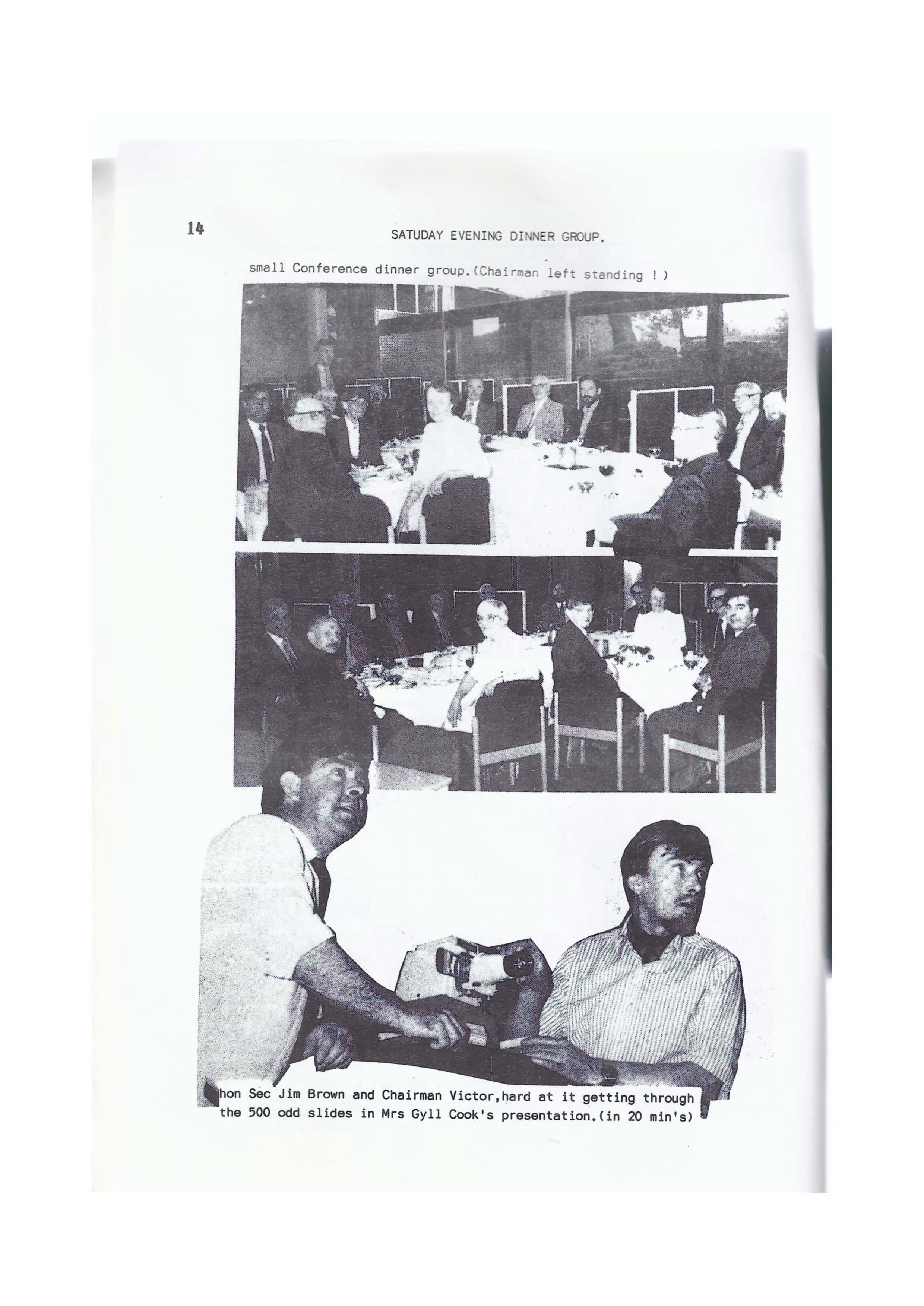
SATUDAYEVENINGDINNERGROUP.
small Conference dinner group.(Chairman left standing
Brown and Chairman slides in Mrs Gyll Cook's presentation.(in 20 min's)
A&HGROUPCONFERENCE
____ ::.ference continued on Sunday with Gwill Owen resumed his t;t.l.lc :-~~•pny 0£ artifacts, & we weN shown some truly first clus
_ : ..: transparencies ot some of his worl:.
-:_ Reed, from Silverprint Ltd then demonstrated the use 0£ a -: :~ tle cutting out 0£ a window in• board when mow-iting photos ~:tiou. Silverprint Ltd speciit.l.ises in the supply of the highest r:ochrome printiny papers & materials, & we were shown Siilllple t raphs priuted on various types of fiber bassed & resin coated papers let us see the different effects available. Silverprint can be contacted ning 01-480 (j625.
After lunch, Jim Brown, L.R.P.S., Ar<::h~ology & Heritage Group Hon. :ecretary, demonstarated his method of copying old photograpu. His method :s s:u::ple but effective & is as follows:
First place the picture to be copied on the floor. Put the camera, a single lens reflex, on a tripod looking down, with a lamp on each side. :t is i.J.lportant that the film in the camera & the plcture to be copied are Fa.rallel, & Jim Brown then explained how this can be achieved. Simply place a ·rror flat on the itam to be copied, then by looking through the viewfinder of your s.L.R. ca111erayou can judge by the reflection that everything :s square.
The second important thing to check is that tae lighting is properly -alanced. To do this, stand a pencil on eud upon the picture to be photographed, this will indicate the shadows from the lights which can be adjusted .cordingly.
The las.t it.am on the Conference agenda was a talk by Tony Cowell, paotographer from the "Huseum ot mankind" at the British Mu.&eum.He explained · ::,v he photographed the no"' famous "Lindow Man", an ancient body tol.Uld in il peat bog in Cheshire. He used a Nikon F3 35mmcamera £or colour slides, a Hamyia RB 67 £or monochrome on this assignment, & showed some superb exa:.iples of the photogrilphs he tool of the project.
The R.P.S.Archaeology & Heritage Grol.lp 1985 Conference was a great 5 cess, thanks mainly tc, the efforts of the organiser, Victor J. Heppletbw&ite ._,P.S., our Gro~p C~airinan.
j.Walden.
WANlEO••••••.•••
, Roliei flex Ser: 2

:..enshood
!...anscaps Filters
Please telep~,one Bob on Orpington (6c, :J133
1.5
16
TIM DAWSON,Esq:
HOLOGR.£\M
Demonstrating the HQIQCAM50 CAMERAThe uniQue portable system tor creating Holograms: another first tor the A&HGroup.
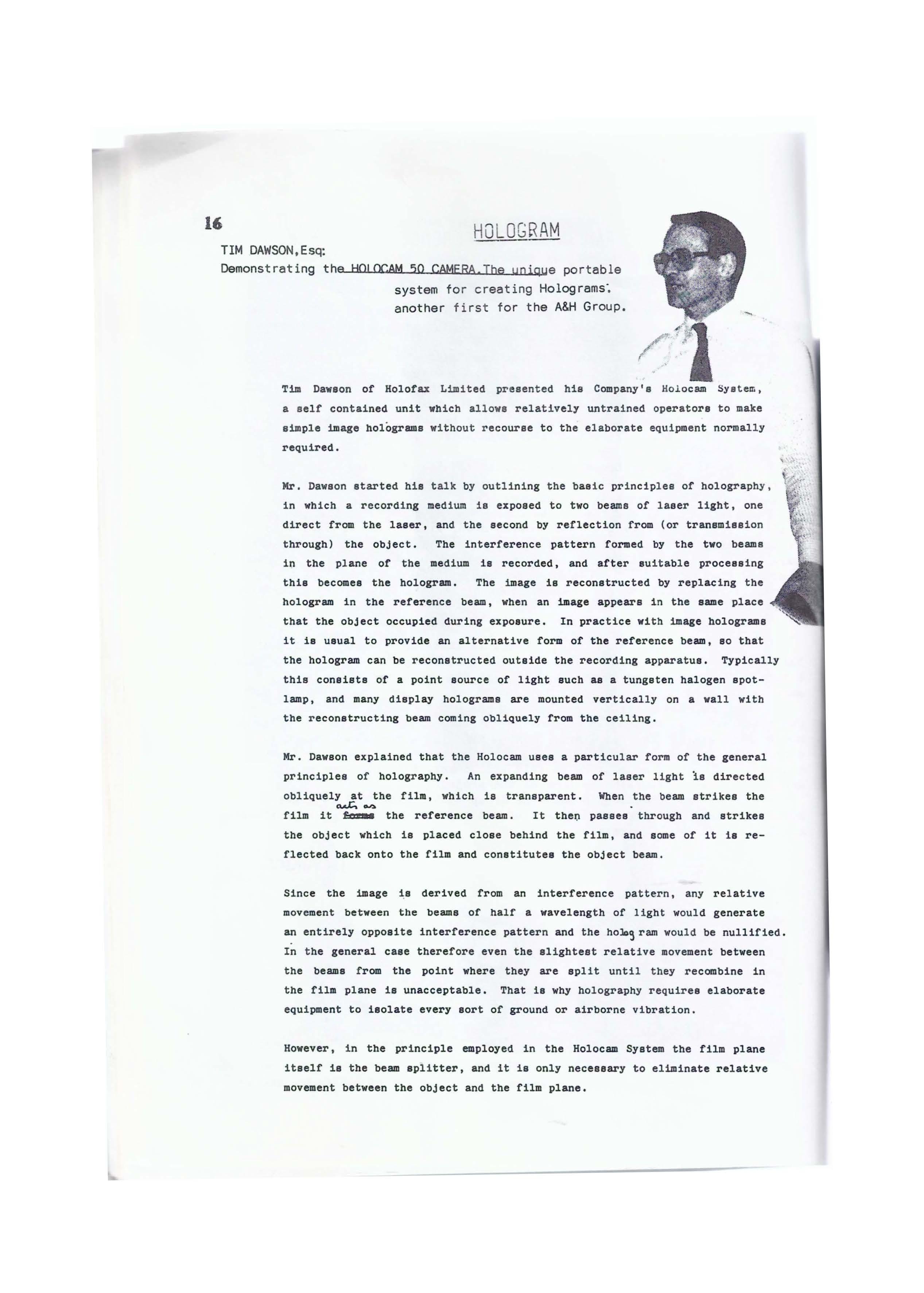
Tim Dawson of Holofax Limited presented hie Company's Holocam System, a self contained unit which allows relatively untrained operators to make simple image holograms without recourse to the elaborate equipment normally required.
Mr. Dawson started hie talk by outlining the basic principles of holography, in which a recording medium is exposed to two beams of laser light, one direct from the laser, and the second by reflection from (or transmission through) the object. The interference pattern formed by the two beams in the plane of the medium is recorded, and after suitable processing this becomes the hologram. The image is reconstructed by replacing the hologram in the reference beam, when an image appears in the same place that the object occupied during exposure. In practice with image holograms it is usual to provide an alternative form of the reference beam, ao that the hologram can be reconstructed outside the recording apparatus. Typically this consists of a point source of light such as a tungsten halogen spotlamp, and many display holograms are mounted vertically on a wall with the reconstructing beam coming obliquely from the ceiling.
Mr. Dawson explained that the Holocam uses a particular form of the general principles of holography. An expanding beam of laser light is directed obliquely at the film, which is transparent. When the beam strikes the .....c...,,. film it i.- the reference beam. It ther;i passes through and strikes the object which is placed close behind the film, and some of it is reflected back onto the film and constitutes the object beam.
Since the image :i,s derived from an interference pattern, any relative movement between the beams of half a wavelength of light would generate an entirely opposite interference pattern and the holo~ ram would be nullified. In the general case therefore even the slightest relative movement between the beams from the point where they are split until they recombine in the film plane is unacceptable. That is why holography requires elaborate equipment to isolate every sort of ground or airborne vibration.
However, in the principle employed in the Holocam System the film plane itself is the beam splitter, and it is only necessary to eliminate relative movement between the object and the film plane,
/
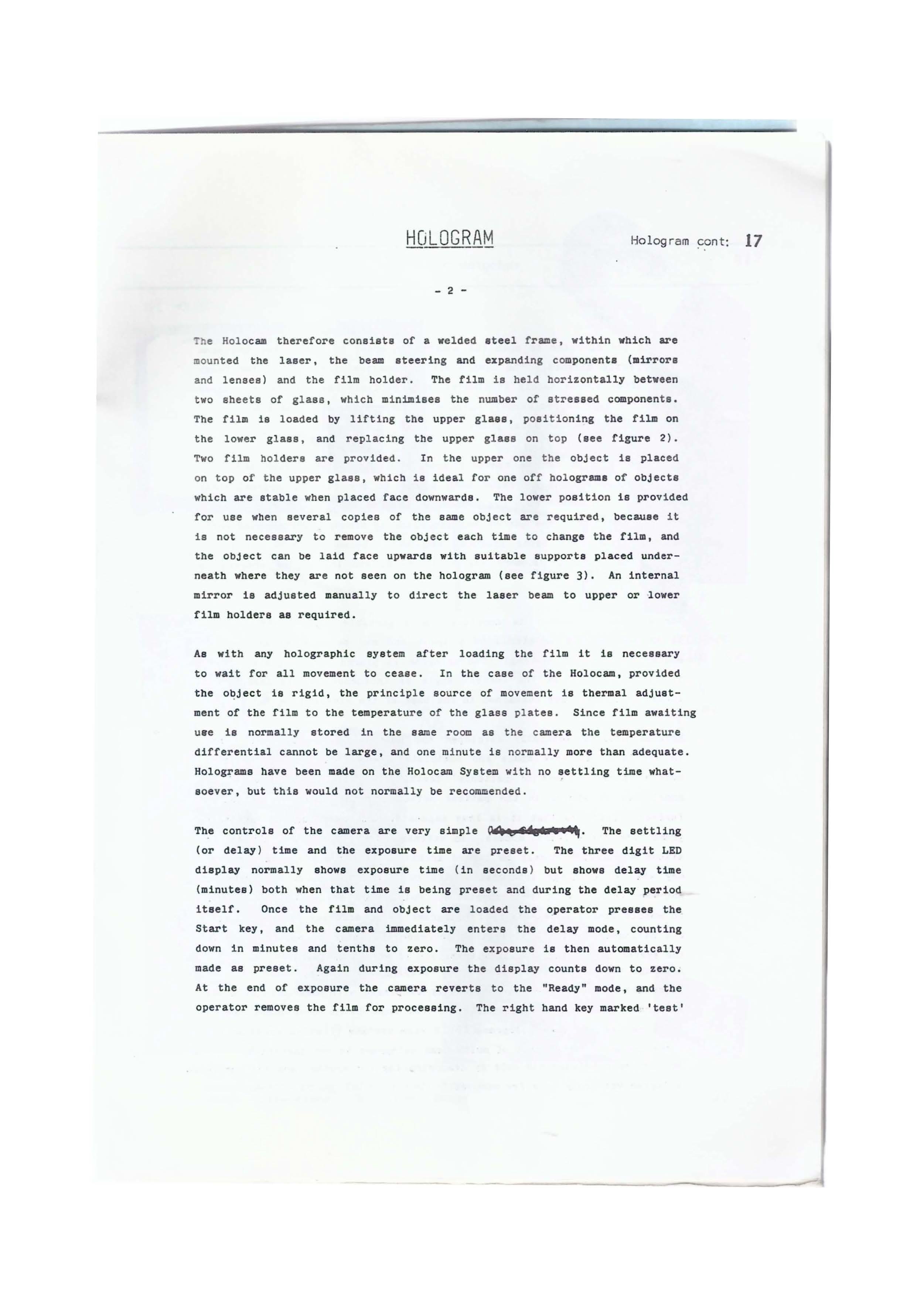
The Holocam therefore consists of a welded steel frame, within which are mounted the laser, the beam steering and expanding components (mirrors and lenses) and the film holder. The film is held horizontally between two sheets of glass, which minimises the number of stressed components. The film is loaded by lifting the upper glass, positioning the film on the lower glaBB, and replacing the upper glass on top ( see figure 2). Two film holders are provided. In the upper one the object is placed on top of the upper glass, which is ideal for one off holograms of objects which are stable when placed face downwards. The lower position is provided for use when several copies of the same object are required, because it is not necessary to remove the object each time to change the film, and the object can be laid face upwards with suitable supports placed underneath where they are not seen on the hologram (see figure 3). An internal mirror is adjusted manually to direct the laser beam to upper or lower film holders as required.
As with any holographic system after loading the film it is necessary to wait for all movement to cease. In the case of the Holocam, provided the object is rigid, the principle source of movement is thermal adjustment of the film to the temperature of the glass plates. Since film awaiting use is normally stored in the same room as the camera the temperature differential cannot be large, and one minute is normally more than adequate. Holograms have been made on the Holocam System with no ~ettling time whatsoever, but this would not normally be recommended.
The controls of the camera are very simple (l~~Cfab& -~- The settling (or delay) time and the exposure time are preset. The three digit LED display normally shows exposure time ( in seconds) but shows delay time (minutes) both when that time is being preset and during the delay period itself. Once the film and object are loaded the operator presses the Start key, and the camera immediately enters the delay mode, counting down in minutes and tenths to zero. The exposure is then automatically made as pre set. Again during exposure the display counts down to zero. At the end of exposure the camera reverts to the "Ready" mode, and the operator removes the film for processing. The right hand key marked 'test'
HOLOGRAM 1-fologram cont: 17 - 2 -
18

Hologram cont:
enables the operator to open the shutter in order to check that the beam 1a correctly aligned. The camera will automatically revert to the ready state after approximately 10 minutes, alternatively the operator may press the centre key (marked Cancel) which will also return the camera to "Ready" if pressed during the delay phase.
The exposed film can be manually processed, but Holofax have developed an automatic roller processor with a dry to dry time of approximately 7 minutes. In either case the processing stages are develop, stop, bleach, wash, clear, dry. The use of the processor is strongly recommended whenever holograms are being produced regularly, because a more consistent quality of hologram ie more easily achieved, and the drying process is greatly simplified.
The Holocam 50 System is completed by a portable mains power viewer. It is designed to be placed on a table and may be used by an operator either s 1tanding or sitting. The hologram is placed on the platen, where it is illuminated at the correct angle of incidence by the beam from a tungsten halogen lamp contained in the base of the viewer.(~~ .{)
Holofax Limited initially developed the Holocam System to meet a need in dentistry to save apace and administrative effort in storing dental models (plaster caste of patients' teeth). A suitable hologram of the model can be stored in the patient notes, and the model destroyed. A further benefit is that it is less expensive and less risky to post holograms than the original models. By extension there are many other applications which can loosely be termed archiving, particularly where workers may wish to exchange information with colleagues in other countries but not want to part with their specimens. Holofax are now working on a method to enable simple measurement of holograms to an accuracy of approximately O.1 millimetre which will further increase the range of application• for the system particularly as an alterna~t~P to stereo photo~raphv. Al though not originally deaigned tor diaplay holography, there are items which can be very advantageously diaplayed with this type of aimple hologram. Because of the relatively low coat it ia considered that it could be uaed to make for a wide variety of aalea applications, where the hi&her coat ot holograa ia not Juatitied. llr. Dawaon concluded hia talk by d•onatrating the ayat•, and the completed hologram waa ready in a few
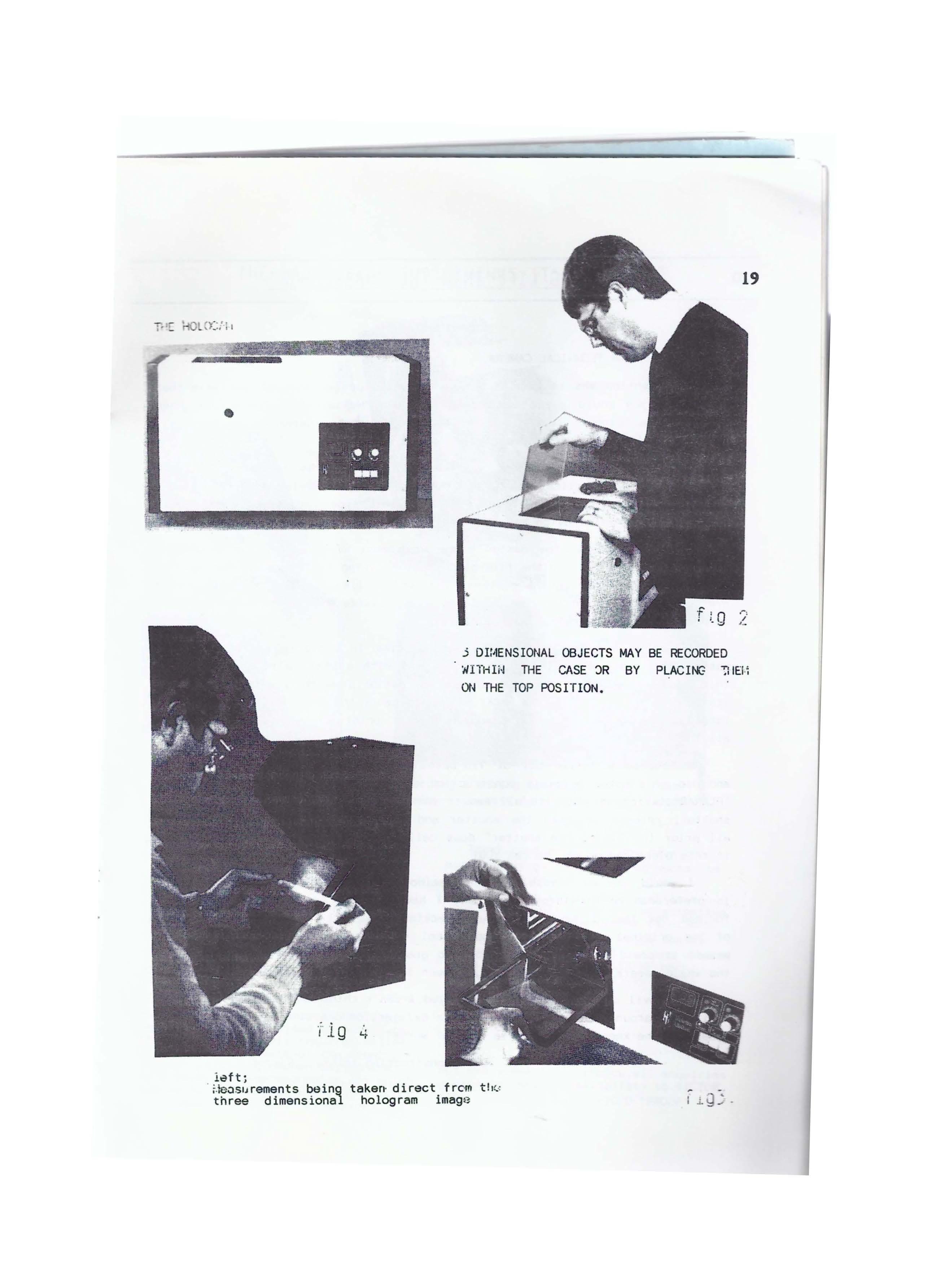
.5 Dit,JENSIONAL OBJECTS MAY BE RECORDED 'IIITMii·l THE CASE '.)R BY PLACING ;1 IEI,; ON THE TOP POSITION.
..
1,3ft; · f.!eos1Jrements being taken· direct frc-m tk: three dimensional hologram imag13

BREATHINGLIFE INTOTHE"HASSELHOF"
BUILDII\G YOUROWNTEQ-INICALCAMERA.
My intention was to give a blow-by-blow account,so that if you were that interested you could go off and make your own "Hasselhoff". You do not have to possess a "Linhof" to ~gin with, but one is rather dependent on those all important "Bits" from the Hasselblad.
Yes, I had meant to cover every detail of the "New Hasselblad" system with full patent applications, for other makes like Mamyia and etc; since I am not the possessor of any other camera of this type I cant very well build any thing for them! They do say the road to "H---"is paved with GOODINTENTIONS.
The first stage, the design stage was easy; we all know the advantages of back swing and tilt to the film plane?, and rising front, (rear) for restoring the top (bottom) of the picture. Side shift, likewise permits minimum con-vergence whilst covering an angle of view outside of the screen. (memories of our old friend "Verging-Conve~ticles")
All of these Movements" have similarities in differing planes, so the basic requirment of construction can be met with a beam to mount it all on, this beam i~ capable of see-saw action,preferably with teeth along its length ~J:::il (the RACKJ,hinges to carry the front and rear uprights (standardslwhich will swivel about the center point (node) and there we have all the movements aformentioned.
Of course a little bit of Tin-bashing to make slides for the filmback and use of a Lathe helps in construction of the lens mount for the Hasselblad "PLANAR",(which is what its all about) the rest of the mechanism, to wind the shutter, release i t--open the shutter and iris for viewing and to close it all prior to "Firing the shutter" does call for a little head scratching, but it this bloke can do it; so can YOU!
I would use my "Hasselblad" (HasselHof) Planar every time on MY camera in preference to the larger TOYO 5x4. I have all the Adjustment I could wish for,and now that I have made a new rack(mono-rail ?) from aluminium instead of the original in polished carbon steel <Did it that way just to prove to meself it could be done,and it looks so grand with the black PLANARup front) the whole camera is pounds lighter and much lighter to carry around.
The devil of it is, now its completed,! can't think what to shoot. Perhaps I will get around to building the "Mamyia 6x7 version one of these days. (Does any one know how the Mamyia shutter works?.
Good constructing folks, Victor.
20
THEHASSELBLADTHATTHINKSIT'S A LINHOF

turning & boring bearings tor all tour swing movements.A SPECIAL teper is used.
-e prights were assembled from SRB s-eet,the bearings built up by gluing s-~e cheeks tor the required trunion :_a-eter. Roughing out the trunions :- a Taylor Hobson prior to machining --e ,aper bearings on a South-Bend -~: e of War Time vintage.
-,e bearings were machined to a ial taper,providing maximum angle :- -ocation,yet just short of the -_::ie-s "Locking"to-gether.
g unsightly,special "BAG" type ---~ s had to be devised to permit of - ex reme movements required whilst ating the bulk of the front _-:e actuating mechanism,and the __ oack "Wind-on"mechanism.All which be encompassed within the orig-_ -asselblad 'Bodv' dimensions.
Thank goodness I did not have to worry about getting a mirror mechanism in there as well !
The rather large lever next to the lens on the left side, is the actuating performal ALL of the needed functions required to operate the Zeiss lenses · as though they were still on the camera. Permitting tocussing'(with RF back replaced with screen,and use of all normal shutter speeds.
Not everyones first choice.all enquiries ·pl~ase for price,availibility to VICTOR (the :~,ventor & builder)C/0 "PROOF''
21
SUNDOWNER

"Sundowner". 'l'he story of a Yacht.
This fine old 54' vessel was ori:;iinaly built for the Hoyal h·avy, as a ste.m pinnace. She was purchased in ~bout 19JO by Comm.:1der C.H.Lightoller D,S.0,, & Bar, who in 1912 as se::cond officer survived the Titardc disaster, Lightoller served in the Royal Havy duriug the First \Jorld War ,s Captaill of H,M,S, Falcon, "torpedo-boat destruyer until she was lost follolt'ing a collisio & tliler. as skipper of the destroyer H,1•,.S. (;.u-ry which in 1918 rilJllllled& sunk a German submarine, UB110, "Sundow».er" was converted into a single-screw motor-sailor origin.ly by the instalation of a bOhp Parsons petrol-par&fin engine, which was later changed £or a Clennifer 6 cylinder 72hp diesel, The boat is rigged as a Bermuda li;etch, vith her masts set in tabernacles, & h.s a top speed under power of a little over ten .knots.
She was widely cruised in European waters during tae thirtys by Colllllander Lightoller & bis £.unily. In 1939, Lightoller, ·accomp.nied by his wife Sylvia, sailed 11Sur,downer11 across the North Sea to carry out a secret survey ot the German coast for Naval Intelligence.
In 1940, "Sundoil?ler" took part in the evacuation of Allied troops from Dwlldrk, & rescued 122 men from the beaches, returning to England with a total of 130 people on board. She still c.irries with horiout' the plaque "Dunkirk 194011 on her wheel house,&. hiis t.u:en part in many Dunkirk re-unions since the War, 1:-'ollowing the de~ of Commander Lightoller in 1952, "Sundowner" was sold, & in 1975 she vas purchased !>_; :-.r j.:,hn Sapsford who restored her & installed modern navigational equipment including auto-pilot, radio-telephone, radar, etc. She was put on the market earlier this year (1985), & represents a splendid example of a classic vintage motor-sailor.
I wow.d like to recommend an excelent book about the life & times 0£ C.H.Lightoller; "Lights" written by Patrick Stenson, & published by the Bodley He~d, at £10,95 net.
John Walden
22
l. • ...,... 3. 7. n-:-g-;lC. 11.12. 13. 14. •15;•
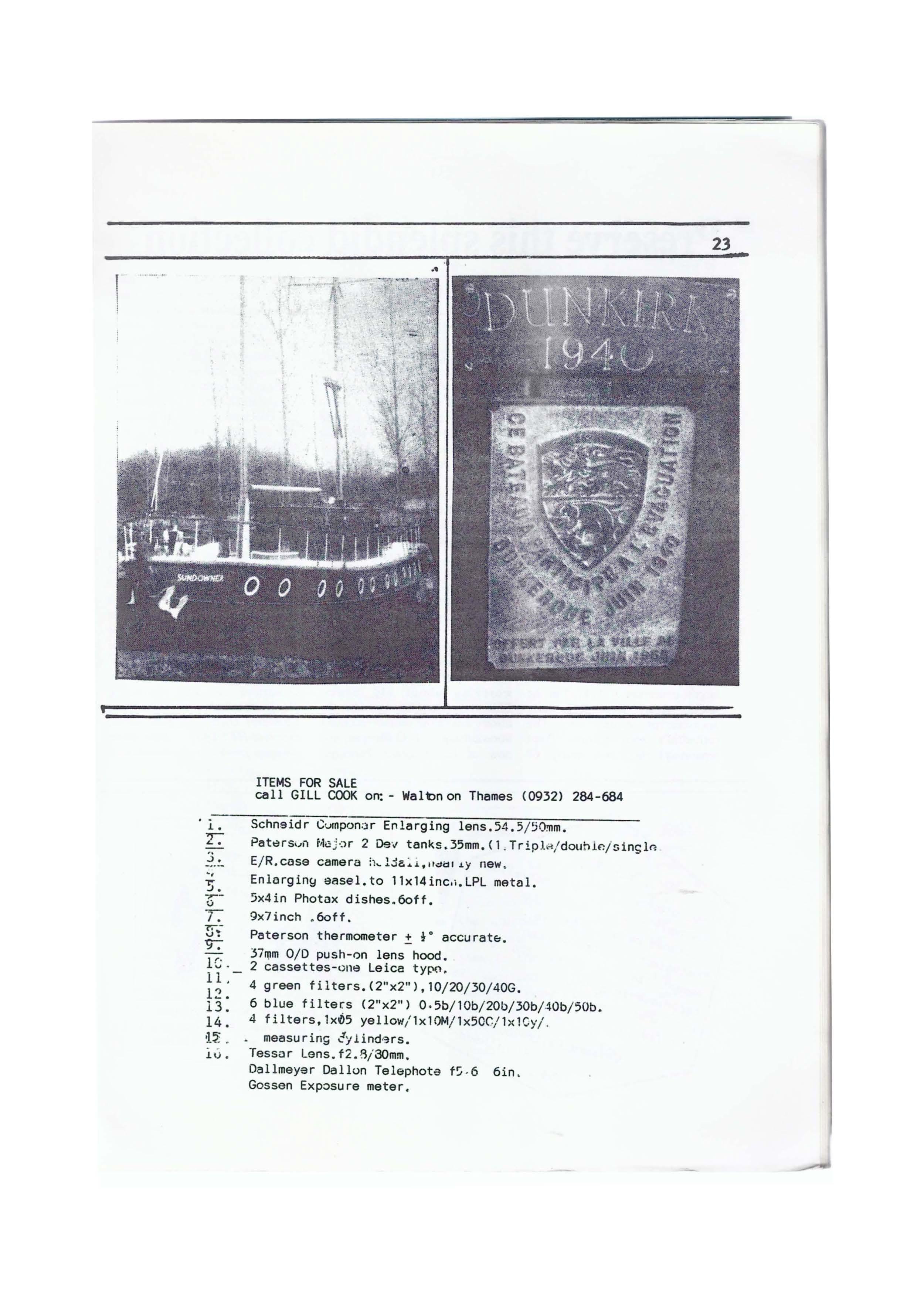
ITEMS FOR SALE
call GILL COOKon: - Waltmon Thames (0932) 284-684
Schnsidr C•Jrnpon::ir Enlarging lens.54,5/50mm.
Pat,3rs,A1 Mcj•:>r 2 De·,1 tanks.35mm, ( 1. Tripht/douhlf:/sin~ln E/R.case camera h~l.;le~i.11<1~1 iy new.
Enlarging easel. to 11x14inc,;.LPL metal. 5x4in Photax dishes.6off, 9x7inch .6off.
Paterson thermometer± i 0 accurat&, 37mm 0/D push-on lens hood.
2 cassettes-one Leica typn.
4 green filters.(2"x2"l. 10/20/30/40G, 6 blue filters (2"x2" l 0,5b/10b/20b/30b/40b/50b.
4 filters. lx\?5 yellow/lx10M/lx5CC/hc1Cy/. measurin9 ~ylind~rs.
Tessar Lens. f2.8/30mm.
Dallmeyer Dallon Telephote f~-6 6in.
Gossen Exposure meter.
l.U,
Preservethissplendidcollection
If you are passing through Hereford you should not miss the chance of a visit to the cathedral library, which may well date from the 13th century and has a continuous history going back to before the Norman Conquest. Five hundred years ago the library's books were kept locked up in chests (one of which still remains) and were so precious that three keys, kept by three different clergymen, were needed to gain access to them. A hundred years later it was described as 'filthy and neglected' and in a 'now all ~ost (sic) decayed' state, but astonishingly it survives. Today it is neither neglected nor decayed - simply impoverished, but with the individual books still chained in their replacement (350 year old) bookcases in the beautiful library room above the north transept aisle.
Whileby modem standards it is a tiny library, with 1,444 manuscript and printed books, it is still the largest collection of its kind in the world. Apart from 227 early manuscript books and the cathedral's own records (kept separately) there are nearly 60
SaysColinCohen,whofindsa deservingcausein Hereford Cathedrallibrary.
Incunabula books printed before 150l. These include two printed by Caxton, which are now just starting out on their sixth century. Also there are a superb volume printed by Nicholas Jenson in 1476 in a roman, rather than black letter type, and one of the first to be printed on English paper, by Caxton's successor Wynkyn de Worde. All of these are relatively recent acquisitions compared to the world map drawn about 1300 by Richard de Bello, prebendary of Hereford from 1305, which hangs at the foot of the steep spiral stairs to the library.
Regrettably this splendid library has virtually no income of its own (it only just covers the cost of heating) and the cathedral itself has financial problems enough without worrying about old books. Effectively, since the last war, the library has relied on the voluntary librarianship of F C Morgan, and now of his daughter Penelope,
while the custodians who ens that it is kept open to the pu every weekday are also voluntee: This is a situation which can continue, on top of which there no money available for in;iporta:. conservation and repair work. TI result of this must be that as boo deteriorate they may have to be so at a knock-down price to someo who can afford the repairs, th breaking up a historic collection.
The library originally set its the task of raising £100,000 to up a fund to generate income to p for these essentials. But, while g progress has been made in raising, inflation has meant that t original target is now insufficic and more money is needed preserve the integrity of t magnificent collection. I can thi of no more appropriate way for t trade to show its generosity than donations - or by having th names inscribed in the benefacto book for subscribing £100 or mor Donations to The Secretar Hereford Cathedral Library Appe Cathedral Office, St John Str, Hereford HRJ 2NG - from wh covenant forms can also be obtain

'When you get to my age the phone features you need most are memory and handsfree loudspeaker operation.'
2 ~.
Dear Victor,
This i3 just a Quick note to let You kno,v that I have gained my LRPS, by dint of a colour Slid P0rtfolio, Which included one archaeology Picture and some other re1 -ated mater ia 1. I attended the 'Open• Judgin:1 in South.:1-npton an was gratified by the gOOd receptio my slides had among the Judges.
Next step certainly has t be an ARPS ir. Archaeology & Heritag stuff
Many thanks for the dat abouit the book by 'YOB•; Ive Ord -ered it from a Manchester bookse11e I hope to hove it in 2-J Weks.
With best Wishes, Nigel A.J.Niel MA,MIFA,LRPs.
II Evesham, Dear Victor,
Thank You for making Worc•s.
an 8"celJeo, iob of P<inting the a,ticle r sent You. I ••s ,so Pleasect that You were able to make use of it, such
I hoPe we sha11 have gOOd "8athe, to, the Avonc,oft Visit,and I lOok fo'-•<d to seeing You the
'•· Ou, °"My Ofrecto,, M,, Jonny Costigan, •ili, ft •11 goes according to Plan, be our guide for a Preliminary conducted ' toU, Of the ••• ..,. Site, So thot /•tto, lunch eve,y 0 ne >iil hove
/. a better idea of What they are looking at.
Dr.P.Pollitt ARPs.

l'tt Dr Peter Pol 1
f My appolagies to visit Avoncroft Being unable to acted as Brown sec J im however our hon nt1t1ve. represe "fixtures Group "Out-of-Town Few on so many J'ust the as t was the the tu rnou free at ttee members Comm1 the main. time, in f just Instead o land on "Proof" to these t in not take par ttee take waiting for the mat,why field the r Comm1 trips you for you? •. bl e to arrange Victor. trou

HERITAGE IN THEMAKING
2.5

OURHERITAGE IN THEMAKING
Nicholas David Eames is a twenty five year old sculptor who works from his home and studio in the Kentish countryside of Hartley near· Dartford.
A visit has been arranged to talk with Nick and photograph him at work <?n Saturday 19th. July 1986.
The ancient church of All Saints Hartley is nearby offering further opportunities for photography.
This will be followed by tea with Brian Tremain and family with a 'bor_ing' evening of their exploits in the Jorden Valley earlier in the year (video, slides, reminiscences etc.).
DETAILS FROMPROGRAt+1ESECRETARY.
Members will remember 'Brian' as former Hon Sec to this group,his duties as Head Photographer British Museum leave him little time to spare, so that we are indebted to Brian for arranging visit.
(Ed)
27
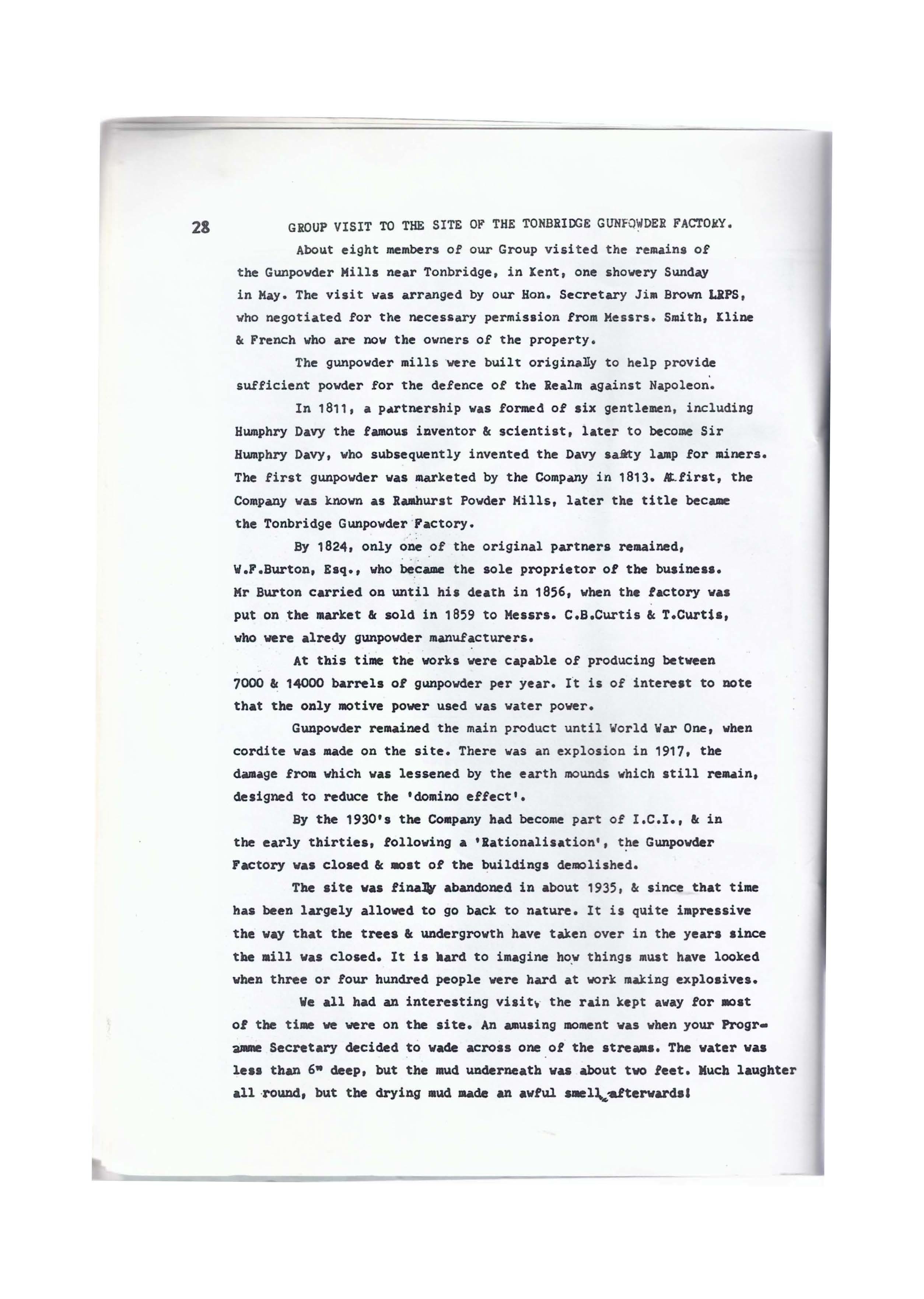
GROUPVISIT TO THE SITE OF THE TONBRIDGEGUNFO~DERFACTOltY.
About eight members of our Group visited the remains 0£ the Gunpowder Hills near Tonbridge, in Xent, one showery Sunday in Kay. The visit was arranged by our Hon. Secretary Ji~ Brovn LiPS, who negotiated £or the necessary permission from Messrs. Smith, Xline & French who are now the owners of the property.
The gunpowder mills vere built originaliy to help provide sufficient powder £or the defence ot the iealm against Napoleon.
In 1811, a p.u-tnership was formed ot six gentlemen, including Humphry Davy the famous inventor & scientist, later to become Sir Humphry Davy, who subsequently invented the Davy aa~y l~p £or miners. The first gunpowder was marketed by the Company in 1813. At.first, the Company vu known as Raahurst Powder Hills, later the title becuae the Tonbridge Gunpowder·Factory.
By 1824, only one 0£ the original pa.rtners remained, w.F.Burton, Esq., who bec&me the sole proprietor of tbe business. Mr Burton carried on until his death in 1856, when the factory was put on ~he market & sold in 1859 to Messrs. C.B.Curtis & T.Curt1s, who were &lr-edy gunpowder manufacturers.
At this time the vorlr.s were cap.able of producing between 7000 & 14000 b.arrels ot gunpowder per year. rt is 0£ interest to note th.at the only 1110tive power used was water power.
Gunpowder rem.ained the main product until World iia.r One, when cordite was llltlde on the site. There was an explosion in 1917, the damage from which was lessened by the earth mounds which still re-.iin, designed to reduce the 'domino effect•.
By the 1930's the Company had become part of I.C.I., & in the early thirties, following a 'i.ationalisation•, t~e Gunpowder Factory v.as closed & aost ot the buildings de1110lished.
The site vu tinallt abandone.d in about 1935, & since that time has been largely allowed to go back to nature. It is quite impressive the way that the trees & undergrowth have taken over in the years since the was closed. It is llard to imagine ho_v things mllSt have looked when three or £our hundred people were hard at work making explosives.
We all had an interesting visit,.- the rain kept away tor 110st ol the time ve were on the site. An a11using moment was when your Progr• a11111eSecretary decided to vade across one ot the streillls. The v.iter vu less than 6• deep, but the 11Udunderne.ath vu &bout tvo feet. H1,1chlaughter all -round, but the drying mud ude an awful smelJ....--altervardsl
28
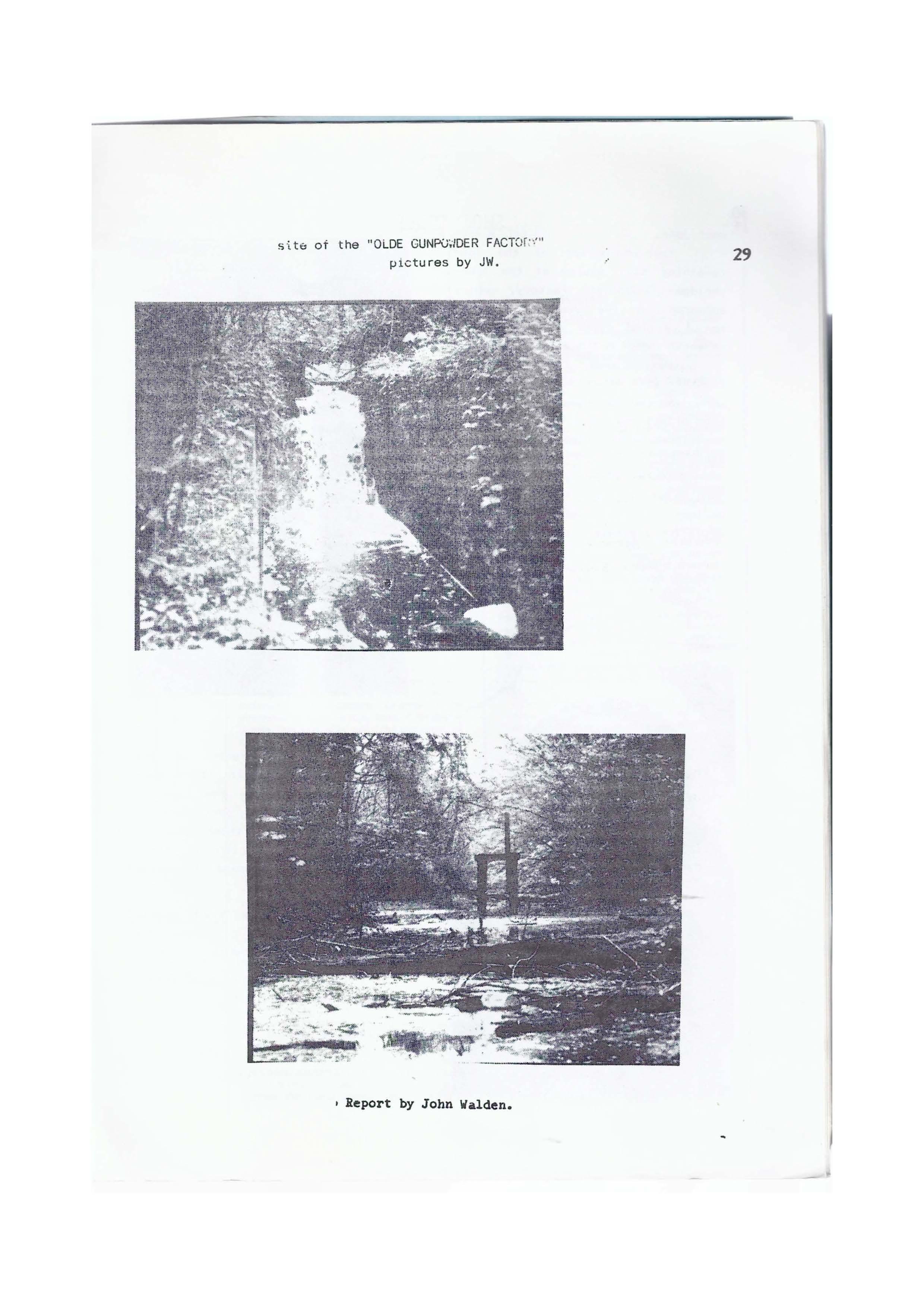 si. te ot the "OLDE GUNPv~IDER FACT()[".'" pictures by JW.
si. te ot the "OLDE GUNPv~IDER FACT()[".'" pictures by JW.
29
1 Report by John Walden.
SHOTTmJER
uear John,
Your photograph of the lastl remaining mill sluice at the Tonb-br idge Gunpowder Factory, whict:, appeared in the J0urnel, reminds me of a shot tower at Crane Park, Hanworth near Fel thani in Middlesex. the sluice is also there together with other remains.
As you can se~ from the enclo-sed prints the tower is well proser-ved. These were tak,;-n about seven years ago.
Crane Park runs alongside the river Crane, Apart from the obvious interest to the Group, it makes tor a pleasant afternoon out.
There are no piarking tacil-ities. Well at least, there were none when I was last there, and, as tar as I am aware there is still none.
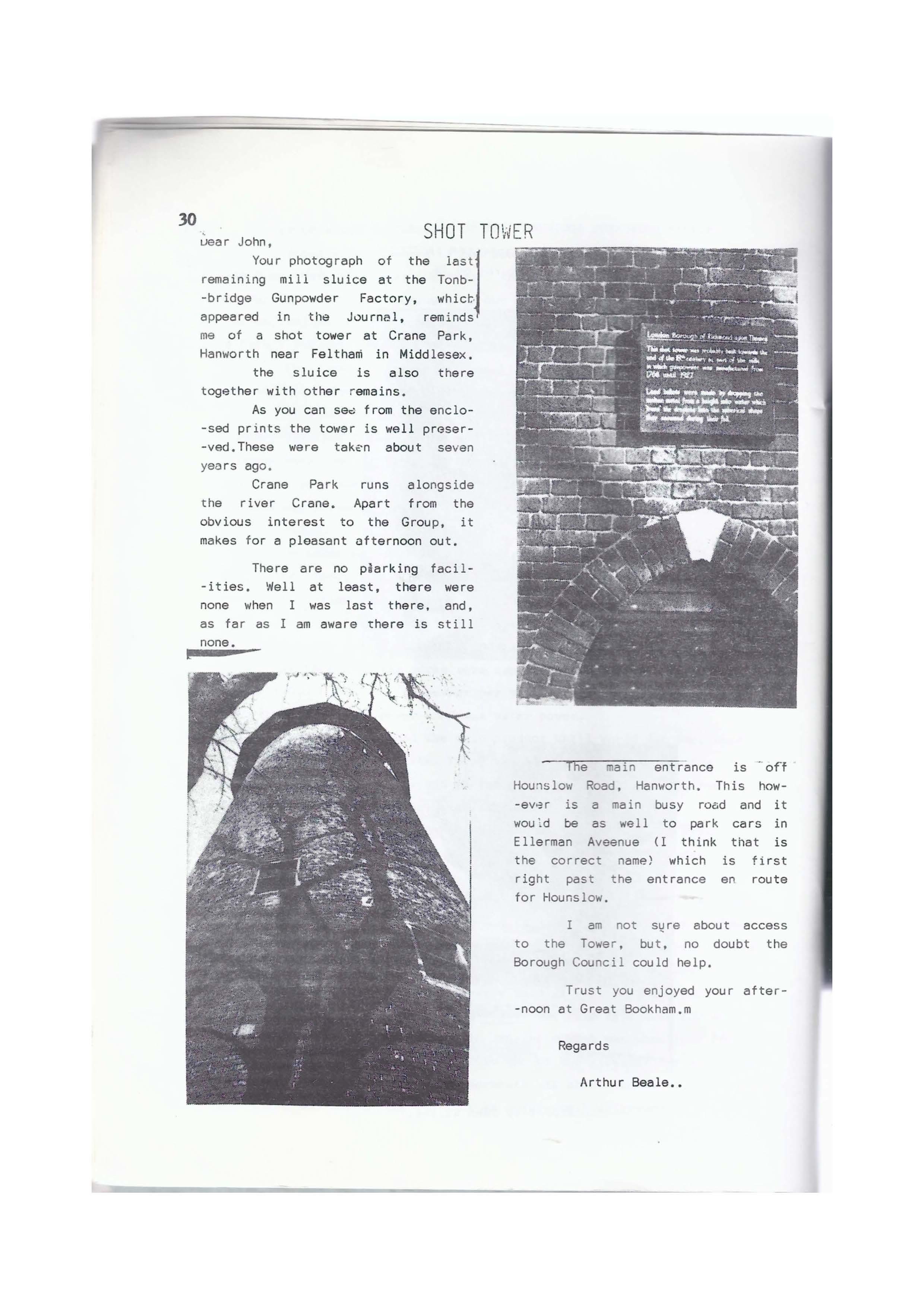
The ain entrance is -off Hounslow Road, Hanworth. This how-ev8r is a main busy road and it wouid be as well Ellerman Aveenue the correct name) to park (I think which cars in that is is first right past the entrance en route for Hounslow.
I am not s~re about access to the Tower, but, no doubt the Borough Council could help.
Trust you enjoyed your after-noon at Great Bookham.m
Regards
Arthur Beale,.
30
,; '. •• "I"'• •• \·~ ~· ·. : !
.; Q) IJl ::, 0 .c * * "O Q) * .c u * +-' '° C +-' +-' '° +-' IJl Q) Q) .c L. +-' Q) +-' Q) C Q) IJl C 0 '° +-' Cl Q) C .:I! L. .... 0 3: +-' 0 .c +-' "O IJl .c w Cl C Q) m E .c +-' .0 ::, 0 0 Q) >+-' :, '° +-' L. .c .c Q) Cl +-' ::, ::, +-' 0 0 Q) >- .c ...... +-' IJl <( <( .... .; >"O'° Q) IJl Q) .c +-' .... 0 Q) u: C .c 0 ...., C IJl 0 "O L. C lO '° Q) Cl '° 15 >m IJl 3'

A PRIVIALPERSUIT
A Privial Pursuit: Youths and Scholars Revel in Outhouses
* * •
ArchaeologistsFind Potsherds Of Some Historical Value; Kids Are Merely Amused
By DAVID WESSEL and SANDRA M. WARO Slt1/f RPportf>T!!.
o/T111-: WALL STRt:t."TJt•l'k:,r,i,,1.
FORT
JOHNSON,
N.Y. -Each summer about 1,000 tourists and uncounted local fourth-graders come to the banks of the Mohawk River to see the sturdy, stone mansion that a Tory fur trader and soldier named William Johnson built in 1749.
The guide usually shows off the marble fireplaces. the walls. thick as a fortress, and the gunports. But she saves the surprise for last: Sir William's privy. "The kids think It's the best part," says the curator, Elizabeth Weidner.
So do some scholars.
Outhouses faded from the American consciousness when Indoor plumbing became popular early In this century. But as historians and architects become more interested in the everyday lives of ordinary people, that everyday item, the outhouse, is drawing academic interest. Privy pits are "colonial lime capsules," says Ivor NoelHume, the resident archaeologist at Colo• nial Williamsburg, Va. And outhouses, themselves, are being preserved: In Shafts• bury, Vt., for instance, the historical society several years ago moved an 1804privy to a local museum, where it is displayed and used.
A Big Picture Book
Not all privial pursuit is scholarly, ofj ! course. Sherman H\lles, a Canadian photographer, has published a coffee-table book on rural outhouses that ls In its third printing, has sold 30,000copies and has earned Mr. Hines about $40,000,he says. Over the years, Mr. Hines has accumulated 20 puns with whicll to inscribe his book, but he says he has forgotten 19 of them. The 20th: "On the whole, it was a wonderful book," he says. And then there's Doss Brown, retired from guiding tourists through Philadelphia's historic houses, who says she began her research on 18th and 19th century "necessaries" because "all the lovely things had been done-like Philadelphia silver." She has already spent seven years on her book, "The Seat of Easement," .and figures she needs another year to fihish it.
Treasure Hunters
Meanwhile, the scholarly study of privies earned Sharon Ann Burston of Philadelphia a master's degree in archaeology. When privies were abandoned, they became places to dispose of the refuse of dally life, she says, and now they yield clues about "people who left no written record."
Ms. Burston based her thesis on the 11,009pieces of bone found when construction work uncovered the site of a colonial privy In downtown Philadelphia. Fifty two of the bones represented the remains of two
IInfants, she concludes in a 1982article, "An Underground Ins_IghtInto Deviant Behavlor
In 18th Century Philadelphia." Both babies were murdered. she suspects, because they were Illegitimate.
l:lut ri:,searchers generally treasure the less gr·,esome objects they fir.d. So do privy poachers, who often gel there first, as one did in the case of an old house in Wilmington, Del.. in 1980. On a hunch that there might be a privy pit at the corner of a: property, Ronald Selin - a bottle hunter who I says he has dug In about 250old prtvles "just as a pastime" - tapped a six-Inch concrete slab until he hit what sounded like a hollow spot. He broke a hole in it, poked a flashlight through and glimpsed a bottle, broken in half. that turned out to 'be about 180 years old. His find alerted scholars, who dug still deeper in whal they determined was a privy used between 1783 and 1820by a merchant named Thomas Mendenhall. The Historical Society of Delaware later organized an exhibit consisting entirely of the 61 wine bottles. 42 Chinese cups and saucers. 19 chamber pots. three whittled toy boats. two pewter shoe buckles and dozens of other artlfacts found at the site.
Noticing a discrepancy between the ornate architecture of the house and the plain tea service dumped in the privy, Bernard L. Herman, a University of Delaware historian, concluded that Mr. Mendenhall made-and then lost-a fortune, a hunch that is supported by mortgage records. "Thomas Mendenhall's house suggests what he thought he should be. His ceramics suggest what he actually became," Mr. Herman writes.
William Byrd's 1730 outhouse, meanwhile, suggests the Virginia writer was "especially imaginative in his pursuit of , private order," says Edward Chappell, the chief architecrurat re';earci-i'er"a't'Wlll1bburi:. The five-hole brick outhouse was designed in Imitation of 18th-century Vlrglnla courtrooms, Mr. Chappell writes in a recent monograph. As the chief magistrate presided from the highest and largest seat , at the center of a raised, semi-circular be~ch, so did Mr. Byrd preside In the family pnvy.
1
1
31
A privial persuit cont:
In light of such findings, It Isn't any wonder that prlvies are now preserved, .especially those with unusual features. In Crested Butte, Colo., where dozens of late 19th-century structures still stand, ,the local planning director says the "most-photographed thing around" Is the two-story outhouse. The second story apparently, was built for use when heavy snow blocked the first floor.
There's another double-decker In Belle Plalne, Minn. Henrietta L. Stiles, who grew up In the 116-year-old adjoining house, now guides visitors and, for the Sl admission price, Includes a postcard of the privy.
Thomas Jefferson, who had many a better idea, designed the superior privy at his Montlcello home, moving the facility Inside and rigging up a. system of pulleys that servants used to haul away chamber pots. Mr. Jefferson also built two octagonal outhouses at his retreat at Poplar Forest, Va. "He liked octagons and used octagons whenever be could;l' says calder Loth, an architectural historian.
Six hundred miles north, William Johnson built his t~holer with only four sldel, but he made It particularly commodious: seven feet wide, six feet long and 12 feet high. He also painted the clapboards oxblood, Installed Georgian-style wood panelIng to match the main house and topped the privy with a bell-shaped roof. The roof lacks the finial that once crowned It, but the president of the local historical society plans to get a new one.

I Plain old privles are preserved, too, but are hard to find because owners consider them a sign of poverty and destroy them or s1IT1piylet them deteriorate. 1'he Society for the Preservation of New England Antiquities Is guarding a seven-hole outhouse In Portsmouth, N.H., that was put up In 1830. And Old Sturbrldge Village, a re-creation of a 19th-century Massachusetts village, has two outhouses. "I wish someone would approach us with more of the proper age," laments John 0 CUrtls, the chief curator.
Sturbridge discourages use of Its privies by locking the door in one case and covering the doorway with plexlglass In the other. Not so the Norlands Living History Center in Livermore, Maine, a place for the curious to ~pend three days living as farmers did In 1870. Norlands has four reproduction outhouses In which the only concessions to progress are window screens and toilet paper.
"We help people establish an Identity with the past," says Billie Gammon, the program's director. "You can't do that any better than when sitting on a cold seat with the wind whistling past." ·
THE WALL STREET JOURNAL,
32
PiCXiRAMMEOF EVJ:?n'S• CONTINUBD.
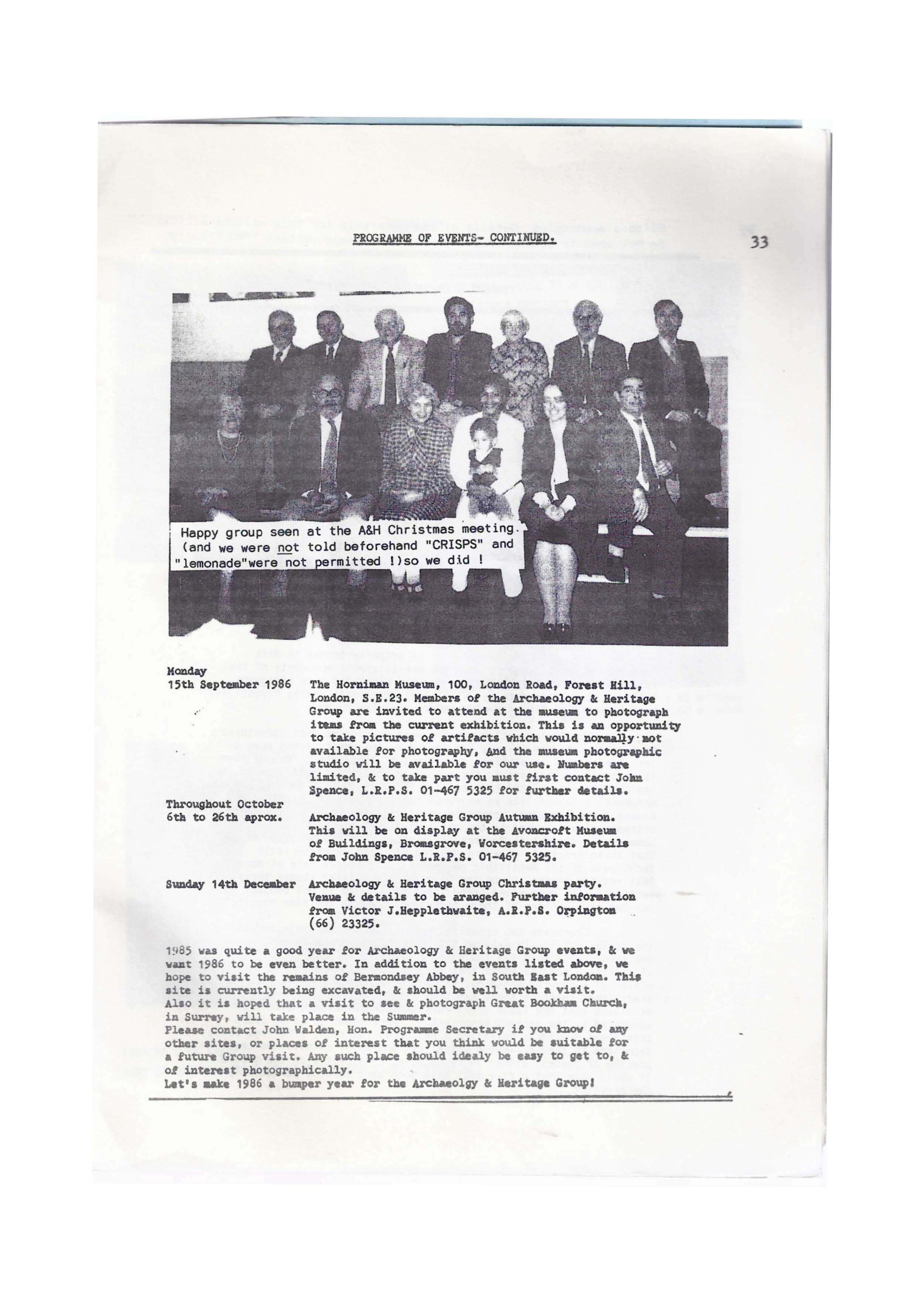
Kond.Ay 15th September 1986
Throughout October 6th to 26th aprox.
Sud.Ay 14th Deceal>er
The Horniun Museum, 100, London Road, Forest Bill, London, s.s.23. Members of the Arch.leology & Heritage Group are invited to attend at the auae1a to photograph i tuia tro,a the current exhibition. This is &n opportunity to t&ke pictures of artitacts vbich vould no~y · aot availal)le tor photography, Aild the 111USeuaphotographic atudio vill be available tor our 1.111e.!J\lllbers are limited, & to take p;art you .l.'irst contact Jolul Spence, L.R.P.S. 01-467 5325 tor further details.
Archaeology & Heritage Group Autuan Bxhibition. This vill be on display at the Avorac:rott Kuae1a ot Buildings, Brcaag~e, Worcestershire. Details John Spence L.R.P.S. 01-467 5325.
Archaeology & Heritage Group Chrisi-a party. Vellue & details to be ar&nged. Further intoraatioJa tl'Oll Victor J.Hepplethvaite, A.1.p.s. o.,,1Jagt011 (66) 23325.
1985 vu quite a good year tor Archaeology & Heritage Group events, & ve vut 1986 to be even better. In additioJa to the events listed above, ve hope to visit the reaains of Beraondaey Abbey, in South last London. T~ site is currently being excavated, & should be well vorth a visit. Also it is hoped that a visit to see & photograph Gre&t BoolthM Caurca, in Surrey, vill t&ke place in the Swamer.
Pleaae co.a.tact John Walden, Hon. Prograaae Secretary it you knov ot &'JI¥ otaer sites, or places ot interest that you think vould be suitable tor a future Group visit. Any such place should idealy be easy to get to, & ot interest photographically.
Let's uke 1986 a b1.111peryear tor the Archaeolgy & lleritage Groupl
33
Editors appologies Details of the ownership tor this welcome article do not seem to be ara.mdWould the Author please contact "PROOF'ISorr}'-.
TORALBAD'ENSALORT(NEARALAYOR)

Top stone:
3.70 m long 1.05 m wide
Base stone:
3.00 m high 2.40 m wide
The Talayotic culture can be properly tenned to date from 1150 BConward and follows the pre-Talayotic monumentsof the island such as megalithic sepulchres and elongated-plan hipogeums, followed at a later date by walls, Taula precincts, salas hipostilas, burial caves and circular-plan and rectangular rooms.
The Taulas, which are the most obvious ancient structures to a visitor to the island, are formed by two great blocks more or less trapezoidal in section, carved out of limestpne. One of them is vertical, either set in the ground or standing directly on it, and the other is placed horizontally above it. Thus the "T"-shaped monumentis formed like an enormoustable (=Taula in Catalan). Around these monumentshorseshoe precincts have been built with an entrance always opened in the main facade and probably with a lintel. Someof the remains in Menorcastill show quite extensively the way that thP.se precincts were constructed with the characteristic techniques of all Megalithic monuments: a double face of more or less regular blocks, or on the basis of large, flat stones thrust in vertically, of good-sized irregular blocks. It is not unusual to see two or all three of these techniques used in the same precinct.
There are two opposing theories about the state in which the Taulas originally existed and to what use they were put. One theory held that the Taula was a great table used for purposes of sacrifice and the other that the Taula was an enonnous central pillar of a covered building, supporting a roof. To these two traditional theories there has been added a more modern one, which maintains that the Taula itself was the symbol of some divinity venerated by the ancient Menorcans. There seems to be no doubt that these precincts fulfilled a religious function, offerings being deposited in them following ritual cutting up of animals and the placing of pieces, either in receptacles or directly on the ground. It would seem that a fire must have been kept burning permanently in the precinct.
TORALBAD'ENSALORT ENTRANCETOTHETAULAPRECINCT
fORRALBA
Ir:·:l'RffilC~ ( CLOSETOMAHON)
TI!ETAULAPRECINCT t
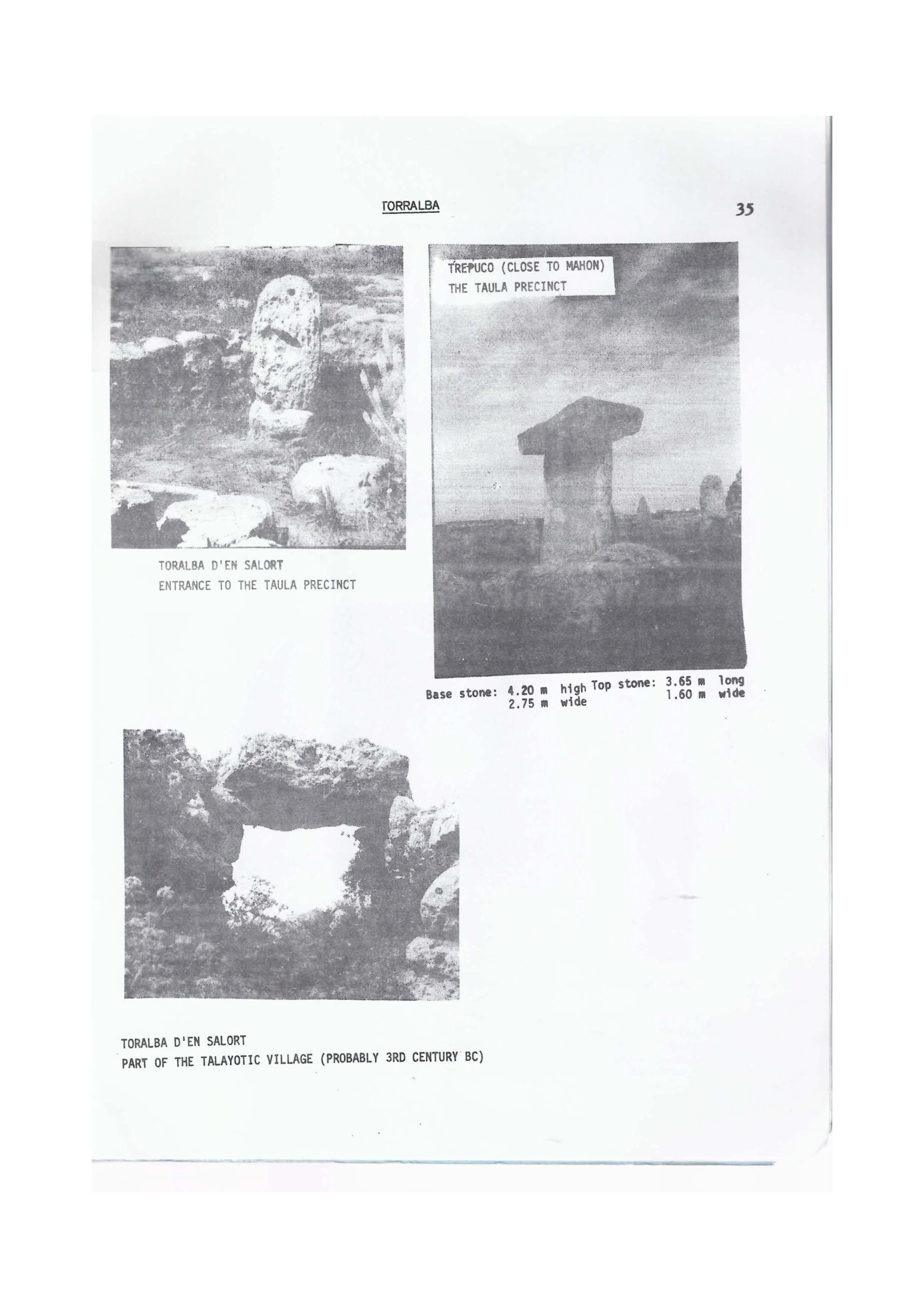
TORALBAD'ENSALORT
PARTOFTHETALAYOTICVILLAGE(PROBABLY3RDCENTURYBC)
Base stone: 4.20 • high Top stone: 3.65 • long 2. 75 • wide 1.60 Ill wide
Jim Brown hon Sec;lost his salmon sandwiches and had to do without his lunch!
the culptit however did not go undiscovered;

illustrations of the armoured knights by Victor.
photography of the Brass tombstones~ proved difficult to say the least,. However resorting to lith derivation and second ~eneration images enabled reasonable illustrations possible.
STOKED'ABERNONOiUROi
37
38 :>•.:i) nc·\~ tt:'r somsthing :::cmpletely di tterent !
Polo Neck sat down on the corner of a thing that could have been a desk, He was trying to appear laid back, like a man who has read about it somewhere
"Ever heard of 'Computer Ego'?" he asked. "Sure," I said.
"It's smart talk for bad man-agement. Office automation for the Gadarene swine - an end in itself. The guys in charge are usually wide-eyed innocents. They know nothing about anything else. They even trust suppliers to give impartial advice."
A voice said "That's right Marlowe, -thing, we've got four of everyand none of them are compatible."
I turned around slowly. I knew the voice, It was Smirnoff. A bit greyer, a bit thinner still 130 Lbs of nothing. I felt as welcome as a Colorado beetle at an Idaho farmers'convention.
"Looking for trouble?" he said. "You tell me, "i said. "I've been hired by P-E Informat-ion Systems. Via Polo Neck here. Not tha~. he told me exactly.
Who hired them I havent worked out, ·voumaybe?"
Smirnoff gave me of smile they usually the kind keep for telling condemned men their appeal has been turned down.
"Follow me,Marlowe," he said. "I want you to meet the screwball who bought all this lot."
To be continued,
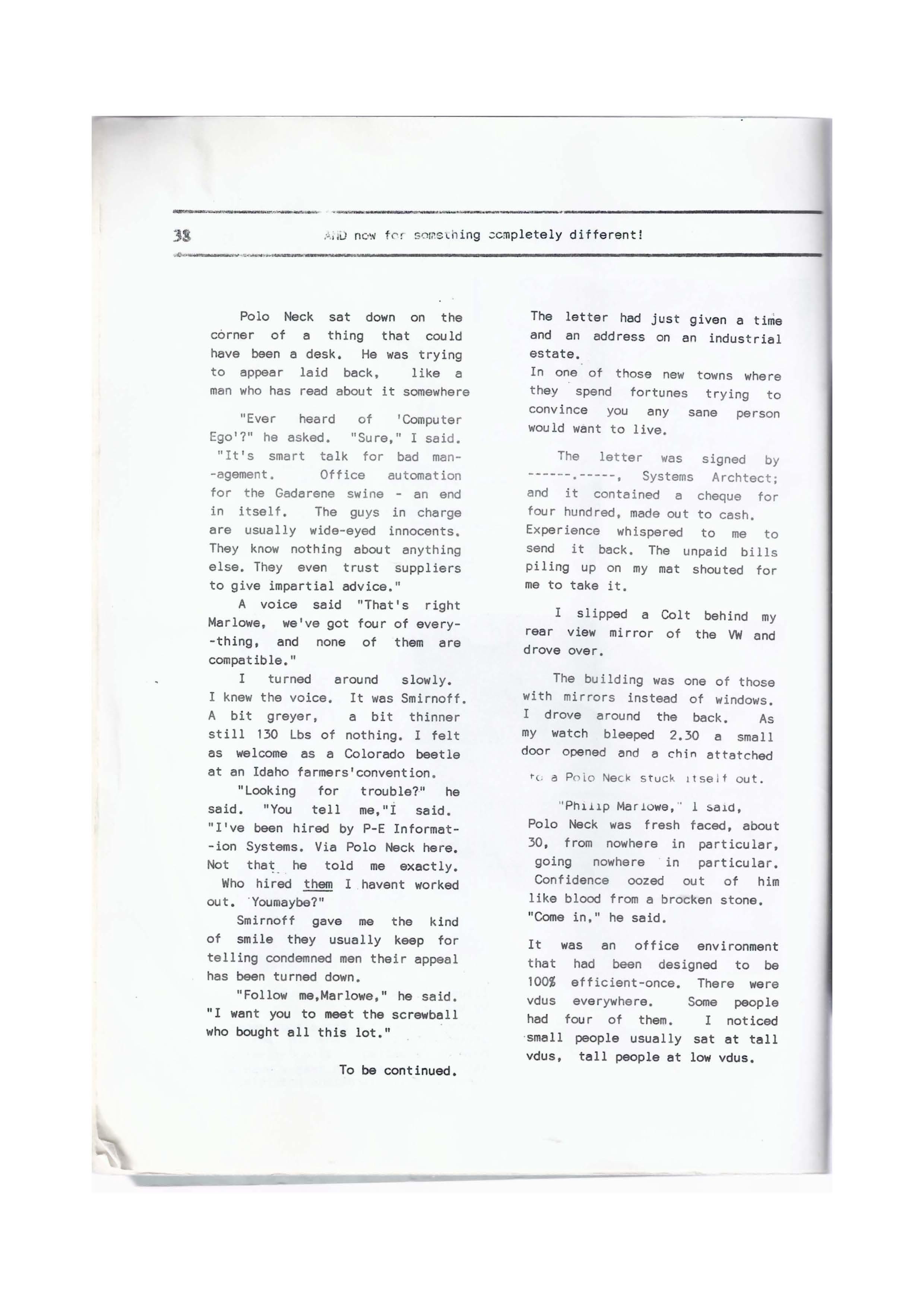
The letter had just given a time and an address on an industrial estate.
In one of those new towns where they spend fortunes trying to convince you any sane person would want to live.
The letter was signed by --. Systems Archtect; and it contained a cheque tor four hundred, made out to cash. Experience whispered to me to send it back. The unpaid bills pi ling up on my mat shouted for me to take it.
I slipped a Colt behind my rear view mirror of the VWand drove over.
The building was one of those with mirrors instead of windows. I drove around the back. As my watch bleeped 2.30 a small door opened and a chin attatched tc a P0io Neck stuck 1tselt out.
"Ph111p Mar !owe, l 5a1d, Polo Neck was fresh faced, about 30, from nowhere in particular, going nowhere in particular, Confidence oozed out of him like blood from a brocken stone. "Come in," he said.
It was an office environment that had been designed to be 100% efficient-once. There were vdus everywhere. Some people had tour of them. I noticed ·small people usually sat at tall vdus, tall people at low vdus,

VISIT TO DOWNEHOUSE - 16tn March 86
Downe House, as it is now, dates back to the late 18th Centur,. ee after marrying Emma Wedgwood, daughter of Josiah, and Charles's first c s , the Darwins moved to Downe house in September 1842, and remained there Darwin's death on 19th April 1882. During those forty years he pub is the results of his researches, notably, in 1859, his work "On the Origi of Species by means of Natural Selection".
We shall have th~ opportunity, under the guidance of the present Custodian, Mr Philip Titheradge, to see the study of the great man, which has been left almost intact after Darwin's death. Members will have to take turns in photographing this relatively small room. Of great interest also is the Drawing Room with many objects relating to the Wedgwood family.
The house will be open tor a private visit by our members from 10.00am. till noon and photography will be allowed in all parts of the house. It the weather.is suitable there is also a magnificent view of the house surrounded by lovely old trees from the gardens and the adjoining field. No entrance tee will be charged, but we are expected to make a small contribution to the upkeep of the Museum - normal entrance tee is £1.20 per adult.
Down House (grid reference TQ432612) is just south of Downe which itself is signposted from the A 233 (Keston-Westerham) road or from the A21 via Shire Lane and High Elms Road near Farnborough. The house itself is well signposted in that area. Parking is available in front of the house.
After the visit all members attending are codially invited to a small buffet lunch and a glass of wine at Elm Cottage, next to Downe Church in the centre of the village - the home of Jill and Alex Simmons. For all additional information, please telephone Alex at 0689 58945
(Thank you Alex tor YOU! arranging this most intere?ting v:i,sit,to Jill-also tor the welcome and buttet.CNOTE) IF YOU are c0min9-,.oo· p.loase notify ALEX Ed.
PHOTOGRAPHICA 86
This is a Photographic Collectors' and Trade Fair at The Royal Horticultural Society's Old Hall, Vincent Square, Westminster, London SW1 on Sunday May 11th, 10.30am-5pm.Cameras, photographs and books will be on sale. Vincent Square is near Victoria Coach and Rail stations or the Pimlico and Victoria underground stations. The Fair is organised by the Photographic Collectors' Club of Great Britain in association with London Photographic Fairs. The address for enquiries is 13a Broadway, Tolworth, Surbiton, Surrey KT6 7DJ. Telephone 01-399 9367.

Why,I ask myself does it always seem to be a tradition tor the Chairman to come out with some platitude? tor the "EDITOR" also to pass on a few words of whatever passes tor wisdom?
Being both at this time, (and is' nt it high time someone else had a crack of tne whip?) places considerable burdens upon ones regular euphoric mental state. Any sort of critism of the Group membership loses ones _tri~n91 overnight! Remarks_: at the (Just1t1ed or not) powers that 1?9,soon l~nd one in hot water.In Committee meetings and group get-togethers I do not encourage "Pol~tical" or. "Religous" subjects,pretering to avoid any sort of argument when there a·re so many interesting things to discuss under the "A&H" banner.
-Having launched "PROOF" Cat cost) and by doing the preparation and artwork myselt,Cas poor as it may be,it does not cost the firm! And to top that Derek Mertield ARPS does the impossible by printing a copy tor every paid-up member tor .the price of the P_il;ltes and paper only! I!!
So when members ask,Where's OUR copy of "PROOF" got to? my first reaction is tell them that I do NOT have to produce a Group magaziryel
Faced with the somewhat daunting taskot collecting articles from reluc-tant member contributors, then asking tor photographs,which have to be sized AND screened (80 dot) and the whole stuck to-gather to make up some sort of readable ,and to Archaeology & Heritage Group members,an intersting,readable NEWS-LETTER.
One that serves both to keep the members in touch with the Group, to encourage GOOD photography in our very ~especial interest,to provide variety,it sometimes a little sauce(y) to what so easily becomesan idigestable diet of stodge!
Not having experience in as,y sort of publishing.and having n~-one (to hand) that is able to help,the effort even Lo think about the problem is for months at a time,just too much.
So that is all the excuse I am going to otter tor the apparent late appearance of this copy of "PROOF".
Now tor some reany good news, no the subs havent gone down,and yes-I did vote when asked that they should NOT be increased.Cl do not subscribe to the folly of raising prices at the least excuse,we have all suffered through rising prices and the younger generation no doubt treat it as an act of nature.)
No one,not one sindle soul has yet offered to even HELP to mount the A&H Group annual Conference AWAY from the Metropolis! with 1986 upon us,a hasty word with the Exec Committee established the simple tact that at least a Conference anywhere has to be better than NO CONFERENCE.
What would YOU do? so I DID, I booked the CRYSTALPALACEvenue AGAIN. I have now selected (and paid tor) the wine,the menu is open at the time of writing. The prog ramm is not altogether settled,although as usual I am not short of the Inspiration mandatory tor these rather grand occasions,last years meet seemed to attract favourable comment because it was less regimented than is usual, well we all learn by our mistakes and in future I shall (as long as it is left to mel avoid any touch of OVERKILL!
I would like to include another session on producing The "PERFECT" negative. The previous one with ILFORDLTD did not achieve the desired result, (in my view) and having been a photographer tutor tor some time now tor the Borough Adu1t Educat ion Committee,I feel compelled to make a better stab at the problem.We shall see.
My page is nearly tilled,but before I finish,lets have some NOMINATIONS tor the NEW Committee tor 86/87. You will be receiving papers asking tor your vote,please nominate somebody (if they agree,ot course) even though they may not intend to actually DO-ANYTHING! I l REMEMBER?Your VOTES are wanted. YOUR letters and ARTICLES will make the next "PROOF"and YOUare the GROUP!
Best wishes tor 1986. v· t ic or,




























 si. te ot the "OLDE GUNPv~IDER FACT()[".'" pictures by JW.
si. te ot the "OLDE GUNPv~IDER FACT()[".'" pictures by JW.









